#i wanted to design sonic but nothing is up to my standards i guess he remains a hedgehog i just dont accept a human sonic at this time
Explore tagged Tumblr posts
Text
ok i drew this so fast when i realized my silver gijinka has to look like a anime protag and also have two ponytails

#hhehehehehheheeeeeeeeee#AHAHAAHAHAHAAHAAAA#silver the hedgehog#they are so fun to redesign#i wanted to design sonic but nothing is up to my standards i guess he remains a hedgehog i just dont accept a human sonic at this time#sonic fanart#sth#this is kinda crusty and ill come back to it but im wayyy too obsessed with these ponytails to remain silent
176 notes
·
View notes
Note
TBH I refuse to play SXS Gens out of pure principle until the option to restore the original Generations dialogues and animations are avaible, fuck the rewrites
I just finished the Shadow portion lol. Overall I feel like you're not missing much. Like, yeah, it's supposed to be an anniversary game and all that, but there's honestly not much in the way of story. You would unironically be better off playing the older games before this one.
I really feel like the "SxS Gens is necessary to catch new players up to Shadow's history" argument is looking a lot weaker now. If anything, you wouldn't understand the emotional resonances behind many of the allusions unless you've played previous games; they don't provide exposition or context within the narrative itself. You wouldn't know that the ARK raid happened because nobody implies as much. The narrative is written as though it expects you to know why Black Doom's threats to possess Shadow are such a big deal.
This game's narrative is about as patchwork as Gens; characters are in nonsensical spots (why do we find Metal Overlord in Kingdom Valley's boss area, but Mephiles in some random cave on the side of Chaos Island's? what purpose did Metal Overlord's presence serve? or Mephiles', for that matter?) and the plot is just "stop giant monster before it destroys the world" sans Eggman. Much peak, many wow.
There's literally no plot progression from point to point; there are six levels in total, and you will only see most of the "plot" unfold at the 3/4ths mark. Until then, you're just running around without much rhyme or reason.
Maria and Gerald are simply there for moral support. They don't really do anything besides that. Gerald justifies this by claiming he doesn't want to mess with the timeline by changing anything.
I went around talking to various characters. Conversations with Big and Maria were the most enjoyable, and I felt like they were the highlight of the game. Rouge gets a bit on-the-nose by comparing herself to Amy when saying she'd support Shadow. Some of Omega's lines strike me as a little acanonical. For some reason, Orbot and Cubot are also there, and you can help them build a rocket by collecting 80 machine pieces. From what I've heard, however, there's no reward for collecting them all, so I was like "lol bye" and left.
I was also disappointed by the lack of a Sonic boss fight. I would have loved a reprise of the original ARK race from Gens; it would have been a nice callback to how you get to see the race from both perspectives in SA2 as well, but we can't have nice things ig :v
Mephiles appears. Lol. Lmao, even. Rofl, if you will. It feels like ST included him solely to riff on the fact that he'll never be canon. He's such a nothingburger of a character and is so negligible as a plot point that he might as well not have been there. He's only there because fans wanted to see him again.
For one thing, you find him in an out-of-the-way cave under Chaos Island. For another, my guy literally says "I just want to exist" and Shadow goes "no. perish." Based, but also, way to waste my time lmao.
Black Doom wants to consume the world as well as possess Shadow. It's not explained how he returned; Gerald handwaves it as "he rebuilt his body through timey-wimey shenanigans."
The gameplay is serviceable for the most part but also incredibly tedious; I found I only enjoyed Radical Highway Act One, and that was because the design was unencumbered by the use of Doom Powers.
Chaos Control and Chaos Spear are your standard abilities, nothing to write home about.
Doom Missile has limited application since only enemies or targets can be shot down, and thus isn't used much.
Doom Surf controls like a friggin' surfing Blooper.

Doom Morph is okay, I guess. Shadow turns into a giant squid and is able to traverse pools of Black Arms juice.
I hate how the Doom Wings control so much omfg. And they say the Homing Attack is a crapshoot. >.>
tl;dr It's okay. Not terrible, but I honestly don't think I'd play it again.
8 notes
·
View notes
Photo
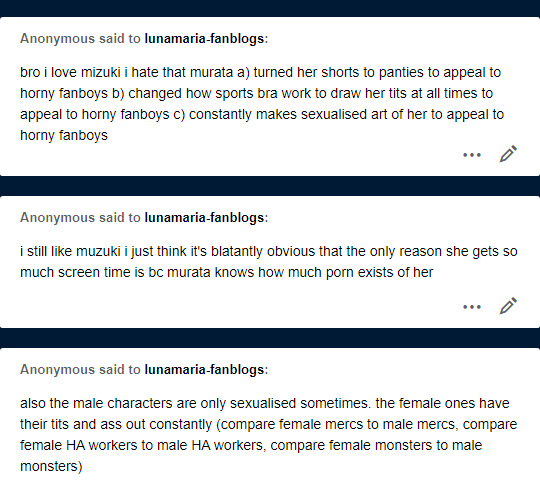
---------------------------------
I'm going to start by clarifying that these are messages I got in response to my post here /// LINK /// After this, I'm not replying to messages about this kinda thing in a long time. Talking about sexualization and such other topics is important but I'm not in a state to be made the center of it. Please, don't come to my inbox asking for discourse, go and create your own posts if you want to raise awareness or vent.
And now to answer to these new asks:
FIRST OF ALL: while I love the way Murata draws men, robotic stuff, monsters... I actually HATE the way he draws ladies! I prefer their proportions in the OPM anime and games. Murata is literally SO BAD at drawing women compared to the level of expertise he has drawing men, and it's all ‘cos he keeps drawing ladies "the h0rny way". We all know this, let's move on.
"He's drawing all the monster girls sexualized" Did the fact that Manako's genre reveal deconstructs the trope "the default is male" totally go over your head? That Psykos's reveal as a woman running the whole MA was a big deal for this same reason as well? There are a bunch of female monsters… you just assume they're all male unless you see big b00bs and then complain about that very fact. They literally made a whole point about this specifically!
"He changed Mizuki's shorts to p4nties to please fanboys" I liked the shorts better too (just because I find her whole character design a bit more balanced that way) so that change bothered me as well, but the "p4nties" are actually standard athletic wear for competition. Shorts are not. Technically, she’s drawn more accurately now.
"Sports Bras don't work that way he just wants to draw b00bs" neither do the shirts and bodysuits the guys are wearing. You can see all their muscles and manb00bs and cr0tch lines, just as much as with Fubuki and Tatsu's hero outfits and Mizuki's top.
"But when the boys are drawn that way, it's not to please the ladies, it's male power fantasy" THERE IS NO HETEROSEXUAL MALE POWER FANTASY BULLSHIT THAT CAN POSSIBLY EXPLAIN THE WAY MURATA DRAWS GAROU, FLASH, SONIC, STINGER AND SOME OF THE OTHER GUYS. The fact is that the way he draws eye candy of them appeals to other collectives other than the cis het men and he knows exactly what he's doing. Period.
"He constantly draws sexualized art of Mizuki to please the fanboys" Why exaggerate so much? This is simply not true. She's a woman in athlete wear, most of the time she's either standing up talking or fighting, no weird angles or anything. There is like 1 sexy cover of her, the back cover with all the girls in bikinis and then that infamous watermelon sequence. That's all the sexualization you are talking about.
"Mizuki only gets so much screen time because of how much p0rn of her there is" oh yeah Mizuki got a grand total of, like, *drum roll* 1 chapter and a half dedicated to her! Wow! Which is NOTHING taking into consideration how dense Garou's arc is and the fact that they will need at least 2 seasons of the anime to finish it.
But think about this: OPM desperately needed more female presence, in special with the prospect of finishing Garou's arc in the anime. Making anime is hard and COSTLY. Most of the people who is going to watch the anime haven't read the manga and they'll be like "what the heck there are no female characters in this anime for like 3 seasons?" and there is no team that's going to risk it working with such prospects. We know why.
Of all the expansion that Garou's arc got in the manga adaptation (and later in the anime), one of the most sensible and balanced decisions was to add more ladies. They put all those monster ladies for season 2, and then for season 3 we get Manako and Mizuki having some strong presence, Shadow and Kamaitachi there a bit in the back too. It benefits the pace and balance of both the manga and the future season 3 so immensely because Fubuki, Tatsumaki and Psykos take a LOOONG while to be relevant during Garou's Arc… in special with all the filler the manga put in between (but all that filler is of the S-Class boys getting development and a reality check which is kinda important too lol).
Point is: the screentime Mizuki got was VERY necessary to balance things in between of all the relentless Garou fights and the boys being boys. Sure Mizuki is beautiful and sexy and all, but really EVERYONE was waiting for a new female character that was relevant, likeable, fun… and on top of everything, it's so rare to see a strong 2m tall girl in fiction in general, not even just anime. Everyone got instantly excited about her because she's exactly what we needed AND MORE. And sure, people draw p0rn of her like they do with most other popular characters, what did you expect.
"The ladies are always more sexualized-" YES, in the OPM manga, the ladies are a little more sexualized than the men –but not by much AND not during plot stuff. By that I mean that most of the so called "sexualizing the girls" happens in the covers, back covers and promotional art very exclusively, and not during the story itself. HOWEVER, a lot of the sexy men bits do happen during the story, curiously.
In the anime though, there is almost zero ladies fanservice (which makes sense since there is almost no female presence in the first 2 seasons anyway). Yet it's full of naked dudes, sometimes for a good reason, but mostly just so we can look at them being sexy and silly.
I personally don't care if the man candy and ladies fanservice is not perfectly even in Murata's manga adaptation, because there is enough of both in his work, as well as other official OPM stuff like the anime and games to bring a very nice balance in the s3xy department.
"The way the women are dressed-" Most of the background ladies are wearing skirt uniforms and shit, but all the relevant ladies primarily dress in nothing you can call "sexualized" except for maybe Tatsumaki with her strong leg game. To recall:
Lilly wears the same as the men of the Blizzard Group; Twin Tail just dresses like a jester; Mizuki is the first to show so much skin, but she's still wearing real standard competition wear for athletes. All the other sportwomen (Hornet and Swim) and martial artists (Shadow, Suiko, Lin Lin) wear standard clothes for their respective professions too. Sure we've seen Shadow wearing some, uh, ninja bikini thing under her ACTUAL work clothes, but for actual fights she's fully dressed and surprisingly not stuffed in a tiny nylon bodysuit that rips like stocking, like all the ninja men in the series do lmao.
Fubuki and Tatsumaki are, like, the only ones wearing dresses and they can because they use psychic powers anyway. Fubuki doesn't even show ANY skin, ever! She just happens to have big b00bs! Kamaitachi is the other one wearing a "skirt" but it's similar to what Japanese martial artists would wear, too.
So, again… all this sexualization we are talking about is not even happening anywhere except in Murata's covers and some promotional art. ONE is famous for treating ladies very fairly, even if Murata tries very hard to exploit the sexy out of every single of the ladies ONE creates. All these ladies have their own agenda and personality that have nothing to do with being pretty or f*ckable. In fact, in-universe, no one ever mentions if the heroines are beautiful or sexy and no one ever talks about liking them for those reasons (except for Lilly and Erika who are gay for Fubuki and Tatsumaki respectively, amazingly enough no hetero characters mention it). I think the first time we've ever seen a relevant character talking about dating another relevant character is when Suiryu told Saitama and Suiko to date (but Suiryu is the resident h0rny fuckboy of the series, if someone was going to say something so stupid for all the wrong reasons, it was going to be him).
For being an adult series, a seinen that parodies shonen tropes and all, OPM is seriously very tame in the sexy ladies department. For this series, the sexy is just a luxurious accessory, just one more little thing. It's always pretty weird when people get so angry and disappointed about a new sexy girl cover or a couple of compromising panels, like they don't know what to expect.
"He only draws that way to please the h0rny fanboys" Murata IS a h0rny fanboy himself and draws shit that appeals to him as much as he feels he’s allowed to insert in the series. Please remember he's the insane fanboy that reached up to ONE to beg him to continue One Punch Man and offered to make a manga adaptation to promote OPM.
From the moment Murata started drawing OPM, the tone of the manga was set and never changed: lots of blood and guts, comical and non-comical nudity, irreverence, sexy angles, Genos ripping his shirts off, ninjas in body suits that rip like they are nylons… people in shirts, tanktops and dresses so tight you can see all their muscles, boobs and even belly buttons whether they are men or women or otherwise… h0rny chapter covers, stupidly h0rny monsters…
Just reading the manga to the point where Genos and Mosquito Girl first appear, you know what you are in for with OPM. I don't know what some fans are expecting to see in OPM next, but I'm going to take a wild guess here and say: you should expect more of the same.
At the end of the day, the manga is Murata's work with ONE, and if he likes drawing h0rny ladies more than boys, that's how things are! This is just 2 guys with their passion project. I don't expect of them the same as if there was a bigger team with a big budget behind the series, like it happens with many games and shows. In this last case, I would be a lot stricter about all this, because with more resources you're expected to do better things.
#one punch man#captain mizuki#tornado of terror#blizzard of hell#psykos#manako opm#fubuki#tatsumaki#opm#manako#lunamaria on the phone
30 notes
·
View notes
Text

(Sorry anon, Tumblr screwed up my draft of your ask, so you’re a screenshot now.)

I hope you realize what you’ve done, because this is going to be a VERY long story. Get a drink and strap in.
Before I can get into this too deeply, we first need to talk about Ocarina of Time. There are a lot of issues I had with OoT that I was VERY excited to see were later addressed by Twilight Princess, whether it was an intentional link or not. There are a handful of things involved here, but for me the biggest one by far is the Temple of Time.
Waaaaay back in the late 90′s/early 2000′s, the internet was still relatively young and, in a way, more simple and innocent. The standard for using it largely boiled down to, “I like [x], so I’ll search for [x]” and just seeing what mess of crap you ended up with. I did this mostly with Sonic and anime stuff, but every now and then I’d do it for things like LoZ as well. One of the sites this brought me to was called The Odyssey of Hyrule, which at the time utterly blew my mind with its content. It was a hotbed of Zelda oddities, glitches (some of which I now see often in speed runs), hoax debunks, and most importantly for this discussion, screenshots from early builds of the game.
We can probably trace the origin of my fixation back to this screenshot:

Those of you that know Ocarina of Time well can probably tell right of the bat that this is not an area that appears in the final game. The website posited that this was perhaps an area behind the Temple of Time, since the setting elements all look the same and the camera appears to be in a fixed location. After all, when you look at the building from the front, there’s a clearly visible path running along the side, and it does appear that the fence has a “gate,” although we can never open it.
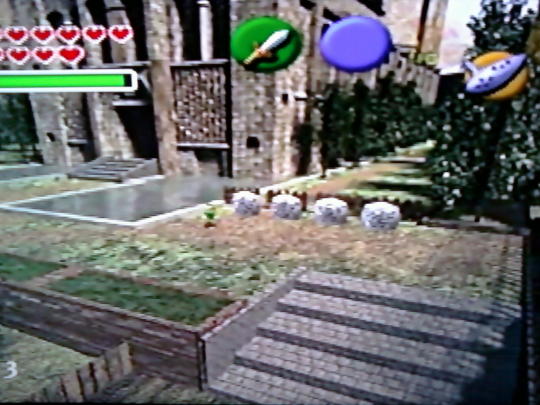
See it there, behind the second gossip stone from the left? There’s a gap on either side of that bit of fence, right where the path happens to be. The rest of the fence on the right side doesn’t have gaps like that, suggesting that this bit of fence wasn’t originally there and the path was once traversable; my personal hunch is that the “gate” is actually a copied instance of the smaller bit of fencing on the left to save themselves the headache of redoing the fence entirely. The gossip stones, if they were originally there at all, were probably supposed to start from the far right wall instead of the left, which would also open up access to the path.
The longer this stewed around in my brain, the more it drove me absolutely crazy, because I realized that this could possibly explain a lot of seemingly disparate elements. For example, there’s a peculiarity in the Temple of Time that’s easy to miss if you’re not taking your time and paying close attention. After you remove the Door of Time to gain access to the sword chamber, the initial view of said chamber is actually much smaller. It’s especially easy to see when you switch to first-person, because you can more easily see how close the walls are on the left and right.
(My apologies for the shitty quality of these pictures, I took them back before we had decent digital cameras. I’ll get better ones when I post this as an actual article on my other blog.)
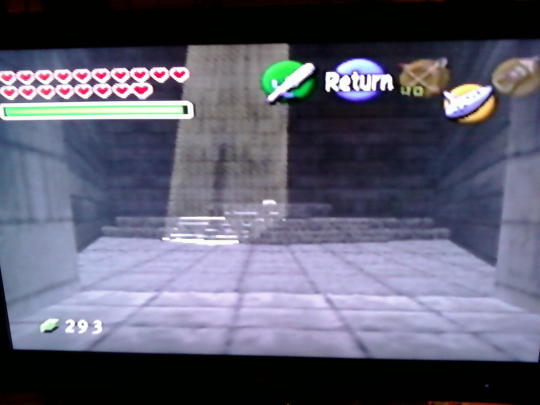
As you run into the chamber, the tight walls abruptly disappear and give way to the massive chamber we’re all familiar with. In fact, if you take your time and walk forward through this hallway, you can easily see the moment when the room changes from small to large before your eyes.
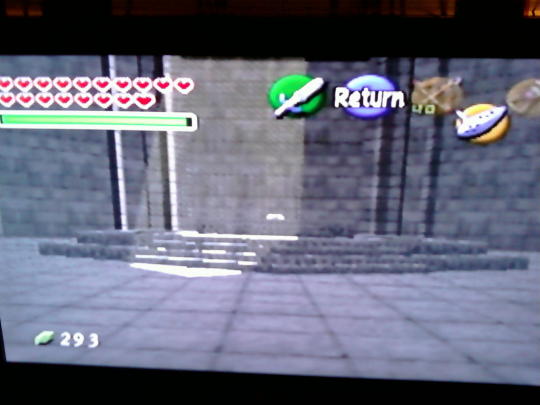
When comparing this oddity with the beta screenshot and the website’s suggestion that the path may have allowed you to go behind the temple, I became convinced that something else was supposed to happen back there, but was cut from the game for one reason or another. My guess is that the sword chamber really was originally very small as it first appears, and the larger chamber was a separate area behind it, which was used for... well, what? It obviously wasn’t something small and simple, like a chest with a heart piece; not for a room that grand. It was clearly for something big, something important, because it had to have a large enough scale of work that the designers looked at it and realized they couldn’t finish in time. After a LOT of mulling it over, I became convinced that it was most likely the entrance to the Light Temple.
You see, something else that always struck me as odd was the fact that you’re just given the Light Medallion as soon as you become an adult. You do absolutely nothing to earn it; it’s all part of the same cut scene that plays after you remove the sword for the first time. You meet Rauru, the Light Sage, pretty abruptly as he infodumps about what’s going on, and then he just forks over the Light Medallion without hesitation.
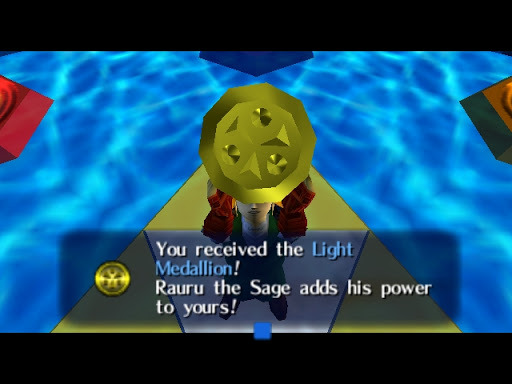
From a narrative perspective, it sticks out to me because Rauru is the only person you do not interact with at any point in the game. You don’t meet him at all as a child, and as an adult you only see him within the Sacred Realm. All of the other sages are people you have both a child and adult connection with in some way, and it’s up to you to awaken them to their powers by ridding their respective temples of evil. Why would they just skip that process with Rauru?
Perhaps they never meant to; maybe you were supposed to go through that same process, but the Light Temple got cut. When you’re designing a video game, there’s a practice that’s recommended before you start actually building it where you make a list of all the elements you want included, then you organize it by importance, and then you cut it in half. The top half is the one you focus on first, because it’s stuff you absolutely positively have to have in the game in order for it to work. The bottom half is stuff you get to include if you have enough time, and it’s added in the order you listed it because top items are more critical. It could very well be that the Light Temple was either on that second half of the list, or it was never on the second half at all but development time simply ran out and it got bumped.
Either way, at some point in the process I think they realized they weren’t going to be able to complete the Light Temple, so they blocked off the side path and expanded the sword chamber to eat up the extra space. After all, you can see how long the building is from the outside, so it wouldn’t make much sense for it to be a reverse Tardis and be smaller on the inside. Once the back path was removed, I imagine they reworked Rauru to reduce his role; my head canon has always been that he was some kind of high priest who oversaw the Temple of Time, since it IS essentially a church. I mean, just look at that garb. He certainly appears to be some kind of holy man.
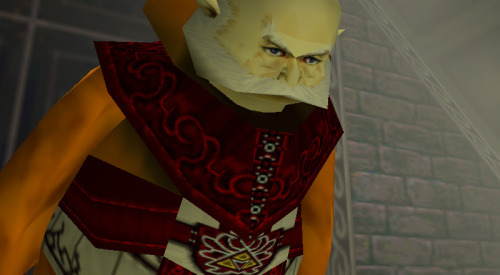
Having him as a priest at the Temple of Time that you could actually meet and talk to as a kid would’ve finally made his presence make sense. It would explain who and what he is at all, since he just kind of appears out of nowhere as the game currently stands, and it would’ve aligned with the other sages insofar as meeting them when they don’t realize their powers, then saving them as an adult and awakening them as a sage. In fact, Rauru disappearing from the Temple of Time would’ve been the game’s first big red flag that something has gone terribly wrong in the last seven years, versus having to go outside to see all the decay and the dark energy around Death Mountain. Furthermore, each sage is someone that the game explicitly positions as a person that makes sense TO be each temple’s respective sage, and to me, a priest from the Temple of Time is the obvious choice for the Light Sage when you consider that the Light Temple is probably part of the same building.
Speaking of the Temple of Time, it has a lot of clues of its own that it may have once doubled as the Light Temple. For one thing, consider the songs that warp you around the game: The Minuet of Forest takes you to the Forest Temple, the Bolero of Fire takes you to the Fire Temple, the Serenade of Water takes you to the Water Temple... but what song takes you to the Temple of Time? It’s not a song with time in the name anywhere, it’s the Prelude of Light. This would make perfect sense if the Light Temple was supposed to share space with the Temple of Time, right?
Another clue is the warp points themselves. Each time you warp to one of the temples, you land on a large pedestal bearing the Triforce. However, there’s another image overlayed on them too: That temple’s medallion. If you play the Prelude of Light to warp to the Temple of Time, the pedestal you land on features the the Light Medallion, as though this is where you were supposed to have earned it.
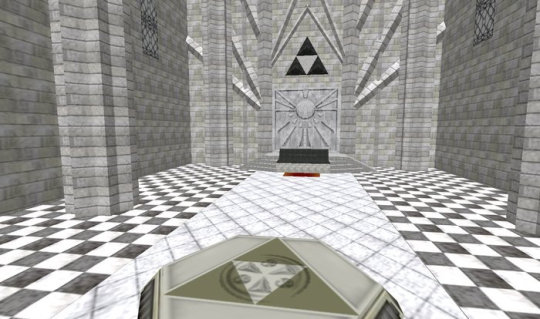
I later discovered that this is even more prominent in another old beta screenshot, which is much more heavy-handed with the symbol on the pedestal.

Something else to consider is the fact that the Temple of Time is actually where you acquire the Light Arrows, the final item that you need before you take on Ganon at the end. Like the medallion before it, the Light Arrows are again just given to you without requiring any work. The other temples all have a critically important item inside that you must obtain to not only finish the temple itself, but that is then needed in other areas in the game. Doesn’t it seem like you’d have to complete the Light Temple to get the Light Arrows, and they’d follow the same pattern of being used to finish the temple and then go on for further use elsewhere (namely, Ganon’s Castle)?
Getting the Light Arrows last also lends credence toward the idea that the Light Temple was in fact lower on the development list, because it would’ve necessarily been the last temple you visited in terms of game progression. They’re not going to give you the ultimate holy weapon early on in the game; they have to save that for the end so you don’t blow through the rest of the temples without a sweat! Additionally, the Light Temple being last would only increase the tension of wondering where Rauru went, since each time you warped between the past and the future you’d have to pass through the Temple of Time and note once again that Rauru is missing.
If it were me making the priority list, the temples would be listed in the same order that you play them in-game, because obviously you need to go through [dungeon 1] before you can go through [dungeon 2] or [dungeon 3].* In this particular instance, chronological order and order of importance happen to be the same thing, and if the development team used the same reasoning, then yes, the Light Temple would be much lower on the list than the others. It’s entirely within reason to think that they had planned for it, but realized they weren’t going to have time to fully implement it, and instead blocked it off and handed over the items you would’ve obtained there so they could focus on getting other, more critical things done.
It’s also worth noting just how much infodumping happens at the Temple of Time. As the game currently stands, there’s very little to actually do at the ToT, but there are many long conversations that take place there. You talk to Zelda, both as herself and as Sheik, you talk to Rauru (as that technically happens while you’re at the ToT), and even Ganon monologues a bit there at the end. You end up spending a LOT of time spent standing around while other characters pelt you with information in this particular location. I’m not saying that there shouldn’t have been any big conversations here, but rather that I feel like there are more than there probably should’ve been. Some (possibly most) of that information could’ve been obtained more gradually and actively if the Light Temple had managed to be a thing.
And look, I’m not saying that what we ultimately got in the game doesn’t work; there’s nothing specifically wrong with the way Ocarina of Time handles the Temple of Time. I agree that getting the Light Medallion and Light Arrows in the ToT isn’t completely out of nowhere since the ToT is connected to the Sacred Realm. I’m only saying it doesn’t come across as the original design to me; as far as I’m concerned, it clearly, obviously screams that what we got was a back-up plan. It works just enough to make sense, but it would work so much better if they did it this other way. Everything just clicks together a little more snugly when you consider that there may have been a sixth temple. It’s not that what we got doesn’t make sense, it’s just that I believe these ideas make more sense.
This topic is something I used to go on and on about back in the day, to pretty much anyone who would listen to me. I was met with about as many different kinds of feedback as you can imagine; some people agreed that I was on to something and had maybe solved a mystery, whereas others thought I was reading way too much into details that just don’t have that deep of a meaning. Unfortunately, it’s obviously not something I could take that far in an argument because there was no way to prove my hypothesis. It’s all just a guess, and even though I think there’s some pretty strong evidence to back it up, in the end I have no way to actually verify it. Sure I could contact Nintendo, but I highly doubt they’d tell me anything one way or the other.
SO NEEDLESS TO SAY when Twilight Princess eventually came along and had a Temple of Time that was a for-realsies playable dungeon with monsters and puzzles and items to collect, I went through the fucking roof.
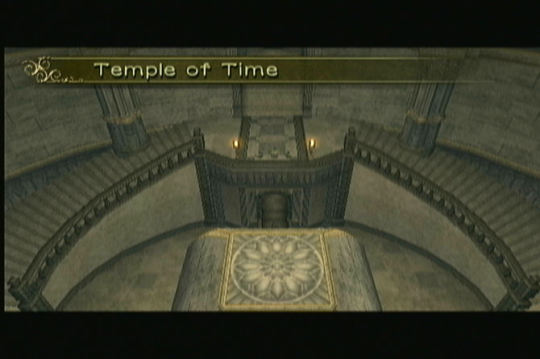
At the EXACT moment that I realized that this is what the game was giving me, I literally screamed and shouted and cheered because I felt so... vindicated, in a way? It felt very strongly like a soft confirmation of what I’d been saying for all these years -- ESPECIALLY since the Twilight!ToT ALSO makes heavy use of the Light Medallion symbol. I feel like that’s about as clear of a connection as you can get.
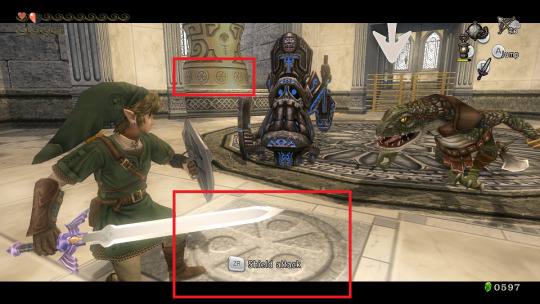
Like, I know the Temple of Time being playable in Twilight Princess doesn’t absolutely confirm that it was supposed to be that way in Ocarina of Time, but it gives me that vibe because it feels like Twilight makes a point to ‘right’ a lot of ‘wrongs’ present in Ocarina. It gives me the sense that they were making up for some of the things they didn’t (or couldn’t) do the first time around. The fact that they were willing to delay the release of Twilight Princess just to make sure everything was just right also gives me that vibe. They could’ve just cut things again, but this time, they wanted to make sure everything was there, and that it was good.
One other thing I’d like to mention before completely moving on from this topic is something that I admittedly can’t confirm, but it’s another point that’s been on my mind: Back when I was playing Twilight Princess for the first time and I was screaming about the Temple of Time, a guy I knew back then mentioned to me that the ToT that we see in Twilight is, canonically, the same ToT that we see in Ocarina. He said that he’d heard somewhere that the Ocarina world map actually fit perfectly when overlayed against the Twilight world map, and the major world features/locations from Ocarina of Time lined up exactly with landmarks and ruins in the Twilight Princess world. I did attempt to look this up for myself before writing this post, but most of what I found was a big mess; I may attempt to line the maps up myself sometime if just to be able to better wrap my brain around what might (or might not) work here. What I can definitely say, though, is that the idea is at least supported by the theme of the series in general, given that it’s based around the notion of history repeating itself. Zelda games reference other Zelda games all the time, so it’s far from unheard of.
Anyway, as I mentioned earlier the Light Temple isn’t the only thing that makes me feel like Twilight Princess is trying to make amends for things that were missed in Ocarina of Time; it just happens to be the one I was most prominently fixated on. Another big thing that Twilight Princess appears to be rectifying is the City in the Sky. Going back again to my old stomping ground The Odyssey of Hyrule, there was another beta screenshot that got a LOT of attention back in the day, because it 1) was an animated gif, 2) involves the Triforce, and 3) appears to be some kind of ‘Sky Temple,’ as it was known.
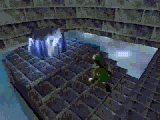
(Once upon a time that gif was reasonably sized, but since computers have roided the fuck out since the days of Windows 95, I realize it’s not the biggest or clearest thing in the world and I apologize.)
As I recall there were a couple of other screenshots that appeared to also be from this alleged Sky Temple, but sadly I don’t seem to have any of them myself, and although The Odyssey of Hyrule technically still exists, it looks like its images are all broken. In any case, the question of whether or not Ocarina of Time was supposed to have a sky temple was a HUUUUGE hot topic among Zelda sites for years. So many people spent enormous amounts of time and energy trying to find the so-called Sky Temple, largely because there was a sizable sect of the fanbase convinced that the Triforce HAD to be hidden somewhere in the game. Amazingly enough someone did eventually find the Triforce obscenely hidden in the game files (I wish I still had the pics of that, the amount of glitching needed to get to it was insane), but nothing was ever ultimately discovered about the Sky Temple. It just became one of those bits of gaming folklore that got passed around from person to person over time.
Which, of course, is why the inclusion of the City in the Sky in Twilight Princess, much like the expansion of the Temple of Time, feels a lot like Nintendo is making up for something they may have intended to do but were unable to complete.

Not gonna lie, when I played this area for the first time I couldn’t help thinking that the small glimpse in the gif above feels like it could feasibly fit in here, and it was just the coolest feeling of, “I knew it!”
Another thing that really bugged me about Ocarina of Time (and in fact still does to this day) is the fact that, even after you beat the Water Temple, Zora’s Domain remains frozen. I never understood how this could be, since every other area reverts back to its original, beautiful form after you defeat the evil in the associated temple. Not Zora’s Domain, though! It’s thoroughly unsatisfying to have gone through what is arguably the most hated temple in the game and not have a full reward for your efforts.
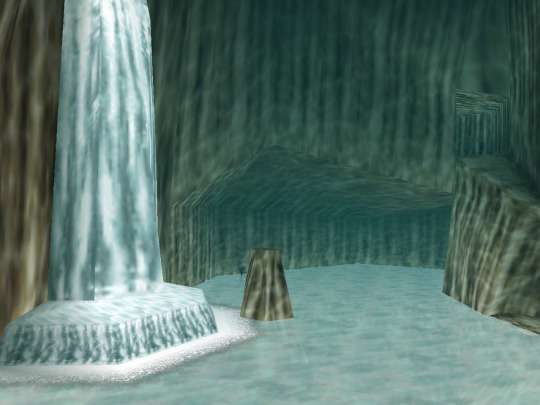
This, again, is something it seems Twilight apologizes for; not only does it actually replicate the original problem of the Zoras getting frozen, but IN THIS ONE YOU ACTUALLY THAW THEM OUT!! And not only that, you thaw them BEFORE you even do the temple! That alone feels like Nintendo practically coming out and saying, “Yeah, we messed up, our bad. Here, have the restored Zoras right away as our apology.” It was such a huge mental release to see that ice melt and the Zoras come back to life! My brain was finally able to let go of a frustration I’d had for years!
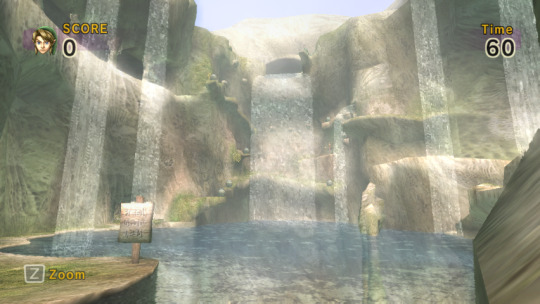
My last one isn’t so much something that I felt was supposed to be in Ocarina of Time, but rather something I just plain wanted to be there. I was always sad that, even though you do technically get to enter Hyrule Castle, you don’t really get to go in there. You get an extremely limited and very linear track to follow, and at best you just get glimpses of some of the other areas that probably would’ve been really cool to explore had the game been designed that way.
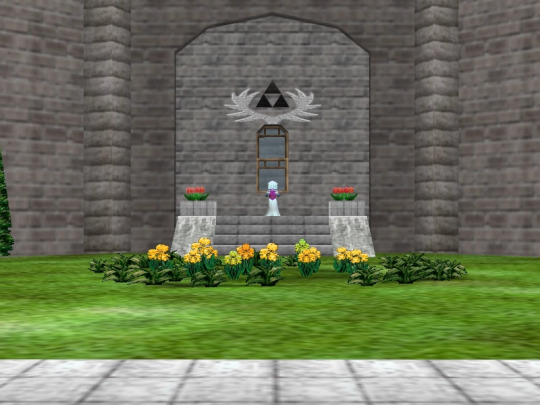
I always felt like the fact that you didn’t get any real exploration of Hyrule Castle upset some of the balance in the game, considering that you do have to fully traverse Ganon’s Castle as a solvable dungeon. Being able to get a thorough sense of what Hyrule Castle was originally like before evil fell would help reinforce just how much things had changed in the seven years that Link was in the Sacred Realm, especially since that contrast is such a strong theme everywhere else in the game.
So, much like my reaction when I realized I was actually entering the Temple of Time as a level, I had a very similar reaction when I realized I was getting Hyrule Castle in the same way.

I may not have freaked out quite as much, but DAMN if that wasn’t another enormous payoff for me! Getting to really look around inside of Hyrule Castle, and furthermore in a version that’s really able to convey the scale and grandness OF a castle, was an absolutely magical moment of overdue gratification.
What’s even better is that Twilight Princess almost gives you a sort of a fake-out in this regard, since at the very beginning you kind of go through Hyrule Castle but, like Ocarina of Time, it’s extremely limited and linear, so it seems at first like they’re going to do the same thing.
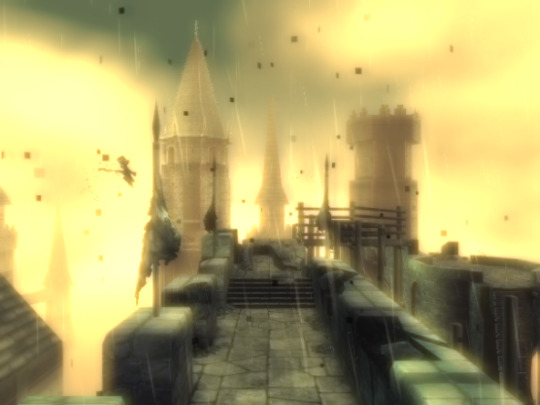
I remember playing this for the first time and thinking, “Well, at least I’ve gotten a little closer to seeing inside of Hyrule Castle, but I really wish they’d just friggin’ let us ACTUALLY go in.” IMAGINE MY CHAGRIN when later on that’s exactly what I ended up doing~ I’m sitting there fan-screaming and the game is going “AH HA I GOTCHA!!”
Soooooo yeah... This ended up being an extremely long post and probably way more than you were ever interested in knowing, but, yeah, I think that’s why Twilight Princess felt like such a bookend for me. Even though I did technically have the original LoZ as a child, my life as a Zelda fan really began with Ocarina of Time, and that game left me longing for several very specific things that Twilight Princess later fulfilled. I’ve never had so many large unresolved issues with any other game, and the fact that Ocarina of Time was the Zelda game that I ‘imprinted’ on, those issues left a very deep impression on me. Having Twilight Princess essentially go back and ‘fix’ those things was incredibly psychologically calming for me, and I think it’s a major reason why I haven’t particularly sought out other Zelda games in the last 12 years. Twilight Princess gave me the things I’d been looking for since 1998 -- a decade of hemming and hawing finally resolved.
I honestly feel like playing Zelda games may be different for me in some way now as I move forward, because I won’t have a part of my brain mentally searching for a way to fill those little voids in the back of my head. I have both Skyward Sword and Breath of the Wild, which as I said in that other post I’ve actually never tried out, so I guess we’ll find out how I relate to them whenever I finally decide to take that leap!
If you actually made it to the end of this post, THANK YOU SO MUCH and I hope you enjoyed it~
*Fun fact, this isn’t necessarily true when it comes to the Fire and Water Temples. The game wants you to do Fire first, but it’s completely possible to do the Water Temple if you want to!
#I TOLD YOU THIS WAS GOING TO BE A BIG ONE#Legend of Zelda#Ocarina of Time#Twilight Princess#anonymous
36 notes
·
View notes
Text
SAGE 2020: Indie Games

SAGE may closed more than a day ago, but thankfully, the website remains up for those who still want to download its games. So even though this article is technically very late, nothing listed here is out of date. The event may be over, but the games live on! Which is honestly a relief, because I think doing ten games per article is taking its toll on me. Normally, when I’d write for TSSZ, I’d do somewhere in the realm of 5-7 games per article, and even that would eventually burn me out. After writing about 20 games this year, I was clearly starting to feel like I was running out of steam. Oh well. We live and learn. Here’s another ten games!
There’s one more article left after this, a sort of “honorable mentions” round-up that will feature much shorter blurbs as I blow through way more games way faster. If I didn’t talk about your game here in these three articles, now’s your chance to let me know so I can say something about it in the final article.
Anyway, onwards to our ten indie games.
Victory Heat Rally
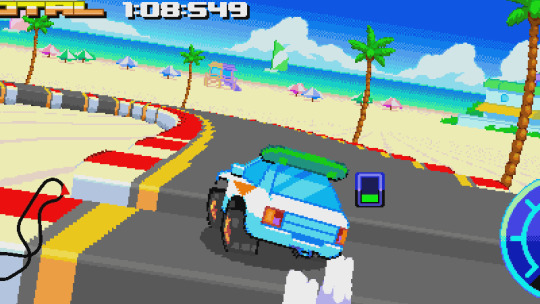
I’m all for any game channeling the spirit of Sega’s old SuperScaler arcade technology, and Victory Heat Rally is all about that. Everything about this game seems so MY AESTHETIC that my only complaint is that I’m hungry for more. A lot more. This demo is a simple time trial on one race track and I’m itching to sink my teeth into literally anything else this game has to offer. There is an older demo from back in April with more content, but it’s running on a different version of the code base -- this newest demo is significantly improved both in terms of visuals and control. I really don’t have anything else to say about it. There’s not much here, but what’s here is charmingly retro in the style of Sega’s Power Drift, but cuter and even more colorful.
Sondro Gomez: A Sunova Story
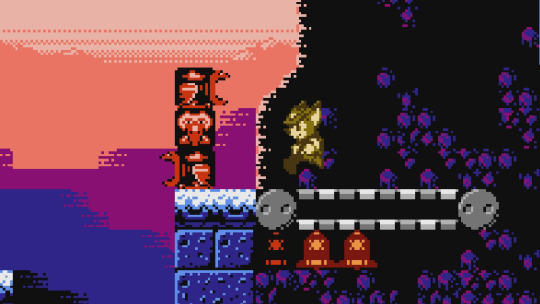
I had been interested to revisit Sondro Gomez after playing the first demo last year, but I don’t know if I just wasn’t in the right mood for it this year or what, but I kind of bounced off the game this time. To my memory, Sondro Gomez is a kinda-sorta side game in the Kyle & Lucy universe. You may remember Kyle & Lucy as one of a growing number of games coming out of the Sonic fan gaming community trying to break out as an original title. A while ago, the developers announced a partnership with Stealth to use the Headcannon engine to make the game with, something that extended to Sondro Gomez here. The problem is, it feels kind of weird now, and I can’t quite put my finger on why. I think it’s the little stuff -- you don’t get a lot of positive feedback when attacking using your whip (the sound is a bit quiet), and the difficulty balancing errs on the side of caution. I died a couple times in my time playing this newest demo, but I wouldn’t characterize Sondro Gomez as a game that feels challenging. Some of that probably has to do with the fact this is still just a demo, which means you spend a long time fighting the same four enemy types in every single level. There’s a lot of charm to the story and the characters it involves, but that only takes you so far when it feels like you’re doing the same things over and over in the actual levels, you know? Either way, the touched up visuals and the new boss fights are welcome. Interested in seeing what the full release looks like next year.
Delta Gal
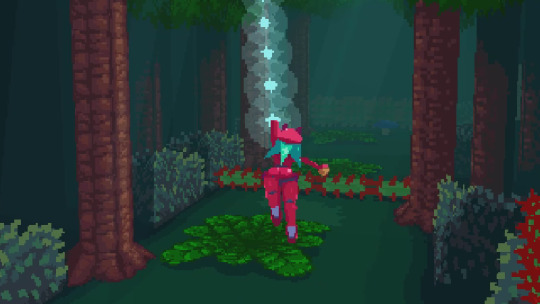
In retrospect, a Mega Man Legends fan game seems like a no-brainer, doesn’t it? Where Delta Gal has a leg up is in controls. Even considering the era Mega Man Legends was released in, it had very awkward controls. Delta Gal’s response is to embrace standard third person action game controls with a mouse and a keyboard. Now, there is controller support, but even once you get it set up, you have button layout presets like “Bad” and “Almost Good.” Honestly, if you can, just play it with a keyboard and mouse. The demo offers about 30-40 minutes of gameplay, with a bit of the town, a forest section, a cave, and one whole dungeon. Visuals nail the best parts of the Mega Man Legends low-fi aesthetic, colors are vibrant, and the pixel art textures look very good. The town is full of characters with lots of personality, too. A particular favorite being the guy who runs the junkyard who likes to show off by flexing his muscles but then ultimately chickens out when it comes to exploring the cave he discovers. The only downside I’d say is the sound design. The game sounds okay, but some of the music is a little bland, and certain sound effects lack the right kind of punch. Granted, this style of sound design isn’t easy, so I can empathize with the developers in that respect. Honestly, it doesn’t really detract from anything at all, so maybe it’s not even worth bringing up. Either way, good stuff, and I’m looking forward to the full release.
Bun n’ Gun
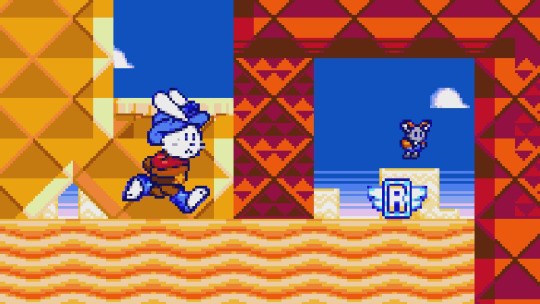
Here’s a cute little game about a bunny in the old west. I’m absolutely in love with the visuals and the music here, but the gameplay is… interesting. Bun isn’t a typical shooter or platformer, thanks to the fact that he appears to only have one arm, which is occupied by his gun. Now you wouldn’t think this would matter, as it’s pretty easy to design a game around only having to jump and shoot, and that’s fair enough. But there’s a strange heft to this character. It takes them a little bit to pick up speed, and it takes them a bit to slow down, and there’s an unmistakable, split-second delay between pushing the jump button and actually jumping. I know enough about this kind of game development that a delay between pushing a button and actually jumping has to be a deliberate design decision, and I split on whether or not I like it. I don’t think I hate it, because it’s pretty easy to get used to the way it feels, but it does mean you’re working with a handicap when it comes to split-second movements. Given the bunny seems to only have one arm, though, perhaps that’s the point. Either way, it’s cute. Give it a look.
Shield Cat
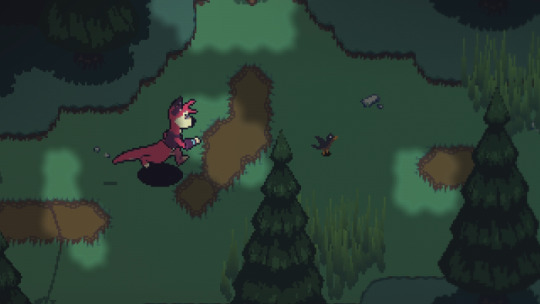
I feel like I’ve been over-using the word “charming” to describe games at SAGE this year, but you know what? Shield Cat is charming as heck. People also tend to think it’s reductive to describe things by comparing them to something that already exists, but I say nuts to that, too. Saying “It’s like…” is an easy shorthand, and besides, if somebody is saying your project is like one of their favorite games, it just means they’re giving you praise and might lack the words to accurately describe that praise. Thing is, that’s actually kind of hard to do with Shield Cat. The nearest relative to this game would be The Legend of Zelda, but Shield Cat honestly plays very little like Zelda, beyond having a top-down perspective. Secret of Mana, maybe, with the stamina meters? I don’t know. Regardless, this is a charming (!!!) top down action game where you roam around exploring an overworld and solve light puzzles. It controls well and the aesthetics are nice. Can’t really get much better than that, though I do have to wonder what it is you’re supposed to be doing in this game. It took me about 30 minutes to see everything available in this demo, but there’s no story setup and only the smallest pieces of what could be considered a dungeon. What’s on offer here is interesting enough that I find myself wanting to know more about this world. For example, it’s called Shield Cat, but clearly you’re some kind of ferret. What’s that about? Guess we’ll have to wait and see.
Prototype N
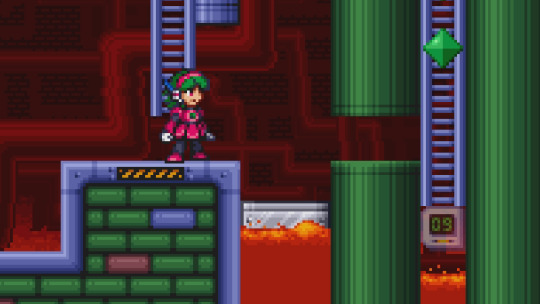
I’ve sat here staring into the void wondering what to write about for this game for a long time, because it’s one of those demos that’s just… a solid and fun game that nails exactly what it’s going for. I would say that Prototype N leans a little too far towards the easy side of things, but the third level provided in the demo ramps the challenge up enough to be just about perfect. And, really, that’s it. That’s the game. You get two softer introductory levels to get you acclimated to the controls (which are similar to Mega Man, but different enough not to be a direct clone) and one “real” level to actually give you a bit of a work out. There’s nothing else to really say. This has the vibe of a 1993 or 1994 Capcom game, or maybe something from Data East. Every single part of this game’s presentation is laser-focused on that aesthetic, and it pulls it off flawlessly. Sound design, music, visuals, it’s a bullseye. This game fell out of a time machine in the best way possible. Definitely give it a look.
Yan’s World
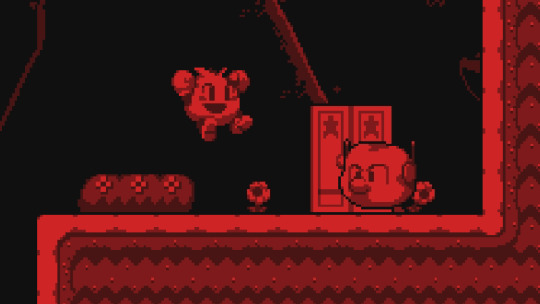
From a game that nails the SNES aesthetic to this, a game which pays tribute to the Virtual Boy… but not really? I actually became aware of Yan’s World many years ago through a mutual Discord, and it always looked interesting, but simultaneously a little confusing, something that still mostly holds true to this day. Per the game’s own Kickstarter sales pitch, Yan’s World is “stylized as a lost title for Nintendo's Virtual Boy.” I can get down with that, but the game almost instantly breaks its own rule because Yan’s primary method of attack is to shoot a missile from his head that can only be aimed using the mouse. As such, Yan’s World doesn’t have controller support, even though one of the stretch goals currently listed on their Kickstarter page is to make a version that can be played on real Virtual Boy hardware. And, honestly, what’s the deal with this game’s whole… everything else? Why is this kid an onion? Why are the platforms made out of clocks? Why does all of Yan’s dialog make him seem like he’s sort of pissed off when he’s got such a big happy smile? There’s a bit of a hand-wave to suggest the entire game takes place inside of a dream, and for once that actually means throwing logic out the window, I guess. Oh, the missile is a pillow? Fine, whatever. Use it to blast this demonic apple, and then threaten to kill an innocent NPC. It’s a dream! Despite how little sense that makes, it… kind of works? The sprites are big and lovely, the game controls well, and the level design is plenty creative. I can’t fault the game for that, it’s just trying to figure out everything wrapped around the game that feels so bizarre.
Cosmic Boll
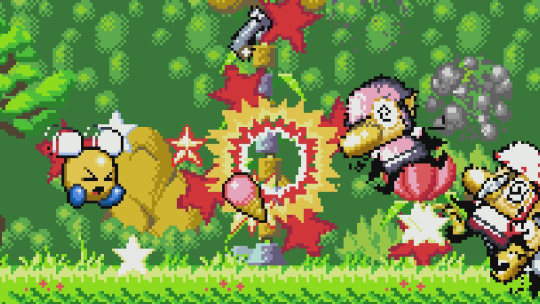
I don’t know if I really understand what’s going on in Cosmic Boll, but I love to play it just the same. This plays like if Treasure made Dragon Ball Advance Adventure while strung out on cocaine. The end result is pure hyperactive chaos. There is a whole complicated combat system at play here, and a very lengthy in-depth tutorial when you first start the game, but you can figure out a lot of it by just skipping the tutorial and playing the game for real. You can get by pretty easily by just mashing buttons and seeing what happens, and that’s not a complaint, because a lot happens in this game. Like, constantly. It never stops, it never really slows down. You’re always zipping around, spinning and flipping and punching soldiers, explosions everywhere, collectibles everywhere, just utter madness. It’s Sonic the Hedgehog plus Devil May Cry plus Gunstar Heroes and all of it is mixed up in ways you probably don’t expect. All of this is to say that Cosmic Boll is messy and cool and fun and you should probably play it.
Brock Crocodile
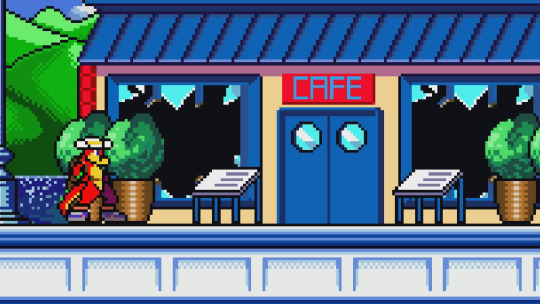
This is a game I’ve seen a lot of around social media, and it’s nice to finally be able to try it. Weirdly enough, this is the first game all SAGE that has flat out refused to see my controller. For the last few years at SAGE, I’ve been using a Playstation DualShock 4, which typically causes me all kinds of headaches with games expecting an Xbox controller. This year, I’ve been using an 8bitdo SN30+. These things are designed primarily to be used on the Switch, but using a controller macro, you can change it to Xbox or Playstation modes. The “Xbox” mode has served me well so far, but Brock here fails to let me use the controller at all. Fortunately, with only three buttons, Brock manages to be mostly playable on a keyboard. That being said, a lot of this game feels a little bit off. The camera is kind of swimmy, as it's almost constantly in motion trying to get a better angle on what's around you. Brock himself doesn't have a smooth acceleration curve either -- it's more like shifting gears in a car, where you reach one top speed and then click up into the next highest speed. That can work, but Brock changes gears much too quickly and without much feedback, making it look like one jerky acceleration curve instead of two. And then there’s the visuals. Level art looks great, character portraits look great, but I’ve never been the biggest fan of the sprites I’ve seen in this game. Take Brock himself, for example: he’s got insanely thick thighs for some reason but the rest of his body looks thin and wispy, and he stands with kind of weird posture. The good news is, despite these complaints, Brock Crocodile is actually really fun to play. You eventually get used to the game’s control quirks, and the level design and included boss fight are excellent, striking that perfect balance where they aren’t too easy but don’t feel unfairly difficult, either. Plus, even though the cutscenes aren’t skippable (annoying as I was dealing with controller issues), the writing is snappy and the dialog is funny. It may not be perfect, but there’s still a lot to like here.
Marble Launcher
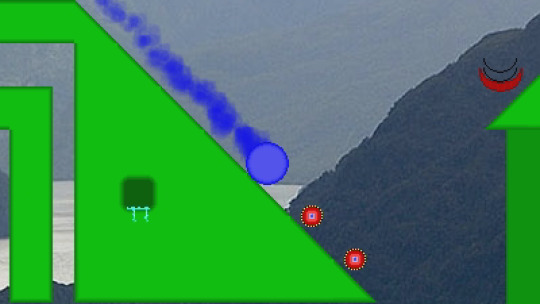
Here’s one of those games where you can tell the creator is just starting out making games. And that’s great! These sorts of endlessly complex, winding mazes are exactly the kind of levels I started making when I first got into game development when I was 16 or 17 years old. One could spend hours searching every nook and cranny in these levels, which is simultaneously awesome and exhausting. Thankfully, near as I can tell, nothing FORCES you to go exploring, so if you’d rather just finish the game, it’s easy enough to head straight for the goal. Gameplay is extremely simple, otherwise. You’re a marble, you can attack enemies by bouncing off of their heads, and you have a slam move. That’s it. You might think that with this being a marble game, you’d get real rolling ball physics, but all you get is simple platformer controls. They’re good enough, especially considering how esoteric the shape of the levels can get, but it’s hard not to be a little disappointed. Still, it’s not a bad little game for what it is. Controls a bit better than some of my earliest attempts at game development, too.
Thirty games total! That’s a lot of games to talk about. And there’s still more to come, so stay tuned for that.
#sage#sonic amateur games expo#writing#review slew#indie games#victory heat rally#sondro gomez#delta gal#bun n' gun#shield cat#prototype n#yan's world#cosmic boll#brock crocodile#marble launcher
5 notes
·
View notes
Text
Fantastic Four Vol 1 #200
Mon Aug 26 2019 [01:59 AM] Wack'd: Alright, here we go. [01:59 AM] Wack'd: FANTASTIC FOUR VOL 1 NO 200: [02:00 AM] Bocaj: WILL IT BE BETTER THAN AVENGERS 200?? [02:00 AM] Bocaj: HOW CAN IT NOT BEEEEE? [02:00 AM] Wack'd: I just skimmed it and an alien does actually forcibly impregna--nah I'm just kiddin' [02:01 AM] Wack'd: So Doom's throwing himself a little pity party and Reed's like "uh, maybe we hang back a minute?" [02:02 AM] Bocaj: hah [02:02 AM] Wack'd: But Ben is, of course, not having it [02:03 AM] Wack'd: Uh...Ben aided in the destruction of his clone by.......?????

[02:04 AM] Wack'd: His memory doesn't take long to revise itself, does it [02:04 AM] maxwellelvis: By being friends with Reed Richards, I assume? [02:05 AM] Bocaj: Being adjacent [02:05 AM] Wack'd: Oh, in the Saul Goodman meaning of culpability whereby any wrongdoing that sufficiently scars you justifies all your actions [02:05 AM] Wack'd: Sure [02:06 AM] Wack'd: Anyway Doom uses a force field in his suit to shove the Four back to buy himself time to see to his clone's body [02:07 AM] Wack'd: ...they were on a balcony

[02:09 AM] Wack'd: Ben does his usual thing of trying brute force and Reed does his usual thing of randomly guessing why that won't work and being right and Ben does his usual thing of grumbling about it [02:09 AM] Wack'd: Wondering if this is a "Reed and Doom aren't so different" moment or just reenforcing the status quo

[02:10 AM] Wack'd: "Leading an armed insurgency into the UN is the same as giving them a present and offering to depose myself, right?"

[02:11 AM] Wack'd: So the mob's gotten bigger [02:12 AM] Wack'd: I like that Zorbo's got a superhero build and bone structure and literally every other Latverian is still drawn like an extra from a Universal Frankenstein picture

[02:14 AM] Wack'd: Doom siccs a tornado on his subjects [02:14 AM] Wack'd: Coulda done that last issue when the protest started but I guess now he's got nothing left to loose [02:16 AM] Wack'd: Then he takes his personal jet, his statue, and "equipment" he's kinda cagey about to the UN [02:17 AM] Wack'd: Daredevil's gonna sue someone

[02:17 AM] Wack'd: Maybe he'll hire that Matt Murdoch guy. I've heard good things [02:19 AM] Wack'd: Meanwhile, the Four escape. Reed slithers through the door's keyhole at great personal risk because touching anything will vaporize him [02:19 AM] Wack'd: They really should just get a fucking sonic screwdriver [02:19 AM] maxwellelvis: It's Operation! The Wacky Doctor Game! [02:20 AM] Wack'd: heheheh [02:20 AM] Wack'd: So Reed, Sue, and a miraculously-okay Zorbo search for and find Doom's secret plans [02:21 AM] Wack'd: While Ben and Johnny free Alicia [02:21 AM] maxwellelvis: Doom's plan, more or less: 1 2 3 [02:22 AM] Wack'd: Sure [02:22 AM] maxwellelvis: More or less. [02:22 AM] maxwellelvis: There wasn't a panorama of that scene I could grab. [02:22 AM] Wack'd: This is a pretty good moment

[02:23 AM] Wack'd: Minus Johnny's cool-guy posturing at the end there [02:24 AM] maxwellelvis: While also trying to play it cool about how little action he's been getting lately. [02:24 AM] Wack'd: Maybe if he tried asking out someone who wasn't afraid of fire [02:25 AM] Wack'd: ...whatever happened to Valeria from the 5th Dimension? Did they break up in Johnny's solo book or did Marvel just kinda forget about her [02:28 AM] Wack'd: So the short answer is Johnny's solo has been over for three years by this point! And yeah after that everyone just forgot her [02:29 AM] Wack'd: Hell Marvel Wiki doesn't mention any followup on their relationship in Johnny's solo book, so [02:29 AM] Wack'd: Into the ether with her [02:30 AM] Wack'd: Anyway--Chapter 2! We're back to doing chapters now! Exciting! [02:31 AM] Wack'd: The Four and Doom have both arrived in NY. Reed and Johnny are fighting Doom directly while Sue and Ben head to the UN [02:32 AM] Wack'd: Sorry, Johnny overdoes it against some areal missiles and retreats back to the Pogo Plane [02:32 AM] Wack'd: Time for the highly-anticipated Reed/Doom cage match [02:33 AM] Wack'd: Not like this is a team book or anything

[02:34 AM] Wack'd: There's a quick recap before the fight and it's retconned the college actually condemned Doom's experiment to go to the netherworld [02:35 AM] Wack'd: Thus ending one of my favorite dumb bits of comic book lore, which is that Doom got a grant for that [02:36 AM] Wack'd: Round one goes to Doom! Reed tries to dismantle Doom's suit and gets electrocuted [02:37 AM] Wack'd: Probably should've remembered he tried that on a robot two issues ago and got the same result [02:38 AM] Wack'd: Round two! Reed's been lured into the MURDER ROOM! Mechanical tendrils, lasers, robots! [02:38 AM] Wack'd: In keeping with Doom's "fair play" policy, all the traps have solutions, but eventually Reed will be worn down and miss a step and get, presumably, murdered [02:39 AM] Bocaj: Wherein Doom is a Saw [02:39 AM] Wack'd: Meanwhile, in the UN [02:40 AM] Wack'd: It occurs, perhaps too late, that it's probably a bad idea to send a giant-size statue of yourself as a gift to the people planning to vote you out of their organization for war crimes

[02:41 AM] Wack'd: Also: wouldn't be a commemoration of the long, proud history of Fantastic Four without some racial/nationalistic caricatures, I guess [02:41 AM] maxwellelvis: Now, these are his Servo-Guards, right? [02:42 AM] Wack'd: These are humans I'm pretty sure based on the last few issues [02:42 AM] maxwellelvis: I just assumed with how tight to the face those nose things are [02:42 AM] Wack'd: Doom doesn't design for comfort [02:42 AM] maxwellelvis: And the identical sunken cheeks on all of them. [02:43 AM] maxwellelvis: It's one of those things like Psycho-Man's mask [02:43 AM] maxwellelvis: At one point in the 80's the inker forgets that it is a mask and just draws him as a very ugly man. [02:43 AM] Wack'd: In fairness that's a lot of Fantastic Four baddies [02:44 AM] maxwellelvis: I know. It's just those sorts of coloring errors bug me. [02:44 AM] Wack'd: So it turns out Doom is planning on doing something to the UN with this statue and that massive hall of mirrors that's also a solar power center from back in 196 [02:44 AM] Wack'd: Bet you forgot about that thing, didn't you? [02:45 AM] Wack'd: So Doom is about to Do the Thing when Reed surprises him by having broken out of the Murder Room [02:45 AM] Wack'd: (He slipped inside the nozzle of a gas gun and exploded out of its ammo tank) [02:46 AM] Wack'd: Wouldn't be a commemoration of the long, proud history of Fantastic Four without Reed pulling a solution out of his ass that the narrative expects us to believe he had planned from the very beginning

[02:47 AM] Wack'd: How did he fit that through the nozzle of a gas gun, anyway [02:47 AM] maxwellelvis: "Wasn't easy" [02:49 AM] Wack'd: Reed tries to convince Doom to give up on petty revenge and join the good guys [02:50 AM] Wack'd: But Doom retorts that he's not interested in revenge, he genuinely believes he deserves power, because the murder of his mother proved to him that everyone who's not him is a "superstitious, frightened pack of cloddish morons" [02:52 AM] Wack'd: Doom manages to activate his statue which hypnotizes all the UN delegates into attacking Sue, Johnny, and Ben [02:52 AM] Wack'd: And Doom and Reed finally spend a few pages punching each other a lot, which is what we all wanted, I guess [02:54 AM] Wack'd: "I DON'T CARE ABOUT PETTY REVENGE! ALSO, ADMIT YOU WRONGED ME!"


[02:56 AM] Wack'd: And so, Zorbo takes his rightful place as acting leader until elections can be set up. Sets Doom up with some mental health care too which is nice of him by 70s standards

[02:57 AM] Wack'd: It was nice of the UN to let Doom have his evil hypnotic statue back

[02:57 AM] maxwellelvis: And some attempted biblical symbolism from Marv [03:01 AM] Wack'd: Thus ends the first 200 issues of Fantastic Four [03:01 AM] Wack'd: Jesus fuck [03:01 AM] Wack'd: Cannot believe I read 200 installments of anything ever [03:03 AM] Wack'd: I will try not to take a multi-year hiatus again like I did around the time I hit 100
3 notes
·
View notes
Text
First Take Review: Audiovector SR 6 Avantgarde Arreté Speakers
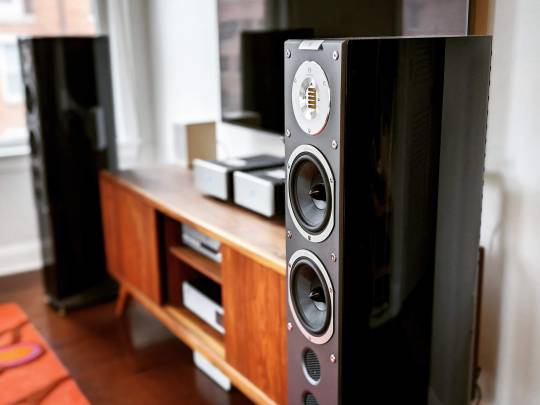
As previously chronicled, a move to a new residence last year challenged my undying devotion to 2-way monitor speakers. Though I had two great ones at my disposal - the Silverline SR17 Supreme and Audiovector SR 1 Avantgarde Arreté - asking these relatively compact speakers to fill a large living space with the weight and scale of a symphony orchestra was unreasonable. I needed something that could move more air, but far too many big speakers I’ve heard sound slow, discombobulated or opaque vs. a quality 2-way. Enter the Audiovector SR 6 Avantgarde Arreté (USD $25,000), which confidently assured me of no such compromises during an audition at Audiovision SF. After a bit of listening to some alternatives and the requisite spousal approval, I traded in the SR 1’s and placed an order for a pair of SR 6 AA in piano black with the intention of keeping these as my long-term reference speakers. I’ve logged about 3 months with them and while they’re still taking their sweet time to break in, it’s time to gut check: are they turning out to be everything I had hoped they would be?
Related Reading
Quick Take: Audiovector R 3 Arreté & SR 6 Avantgarde Arreté
Breaking in a Big Speaker: Week 2 with the Audiovector SR 6
Acoustically Treating Side Reflections: Even Better and Not as Hard as You Think
Design & Setup
IMO this is a gorgeous speaker that looks impressive in a room without being dominating - sleek and elegant, with pleasing proportions and a beautiful finish. While our room is a good size, it is an all-purpose living space for my wife and me plus our two large-ish dogs, and there was no way audiophile speakers with a large footprint or funky aesthetics would ever set foot in our home. The Audiovector was a relatively easy sell to my wife and there have been zero groans or offhand remarks about its size or appearance, which makes it an unmitigated success. The magnetically-attached grills are wonderfully crafted, muting the technical look of the baffle during more casual listening, snapping on and off with precision and sticking together for easy storage. The sound isn't bad with them on either - fractionally less open and bright, which is actually kind of nice for background music.

Full-range speakers can be tricky to position to balance bass response with soundstaging, but in my room I’ve found the SR 6 AA to be very easygoing. Thanks to a combination of front-firing ports, bottom-firing compound woofer and careful bass alignment, they work remarkably well close to the wall. I currently have them with just 50cm (20”) of clearance behind them, and I have yet to pick up on any port noises. Yes, the soundstage would be even deeper if I pulled them out further, but it’s still quite satisfactory and the bass is nicely filled out without any boom whatsoever. As with the SR 1 Avantgarde Arretés, I find the sweet spot to be a bit narrow - sound is good off-axis, but you really need to be centered precisely for the image and soundstage to lock in. This is in contrast to traditional 2-way monitors from e.g. Silverline Audio or Role Audio that disappear in your room with little effort and are fairly forgiving of listening position.
Sensitivity is specified at 92.5dB/watt @ 8 ohms, quite good for a dynamic speaker. Sensitivity ratings can be deceiving (measurement methods are not rigorously standardized) but the SR 6 AA certainly puts out noticeably more sound per watt than the 90.5dB-rated Silverline SR17. I haven't seen an impedance plot or minimum impedance spec but it seems pretty easy to drive, with all of my amps sounding open and unstrained. With pop or orchestral material at moderately high volume levels I could get the bias meter on the Pass Labs XA30.5 to wiggle the tiniest bit, indicating the peaks were surpassing the 30-watt Class A bias range, but just barely. While the speakers can clearly take a lot more power (I would have loved to have the 300wpc Bryston 4B Cubed around), a quality amp of moderate power rating (e.g. 50 watts) but enough current to feed the 4 drivers should have no trouble. The Pass sounded great, I love the 55-watt Valvet A4 Mk.II monoblocks on them, and right now the 50-watt Gryphon Essence is singing away.
The Sound
Listening to the SR 6 AA strikes me as the audio equivalent of stepping into something like a big smooth Mercedes S-class, only to find it as lithe and responsive behind the wheel as a Lotus Elise. But step on the accelerator, and sure enough you will hear and feel the grunt of a big bi-turbo V-12. And most of all, it’s fun. Like a car that beckons you to drive it, there’s an aliveness and energy to the SR 6 that compels you to listen to as much music as possible. I could listen to record after record all day and night and never stop.
Coming back to less-fanciful analogies, I love how the SR 6 has all the coherence, focus and speed of the best 2-way monitors, then adds low-frequency power and dynamic ease without any sort of compromise that I can discern. At first I was a bit concerned with the 350Hz crossover point between midrange and woofer - right in the D to A string range of the violin - but I honestly can not hear it at all. The compound bass system also seamlessly integrates from 80Hz down, and all I hear is a very continuous presentation with consistent speed, articulation and tonality. This is extremely rare in my experience - many big, expensive and elaborate speakers have had some sort of discontinuity that bugged me.
Coming back to the 2-way comparison, I am missing absolutely nothing about my previous monitor speakers. The SR 6 has even more midrange focus and resolving power than its excellent little sibling, the SR 1 Avantgarde Arreté, while sounding less dry and analytical. Much of this can be attributed to the fullness of the lower midrange which puts more meat on the bones of everything. It’s not overtly warm, but has just the slightest bit of extra juice to give pop tunes great bounce and string sections lovely lyricism. My wife noted that orchestral melodies sounded particularly mellifluous and alluring.
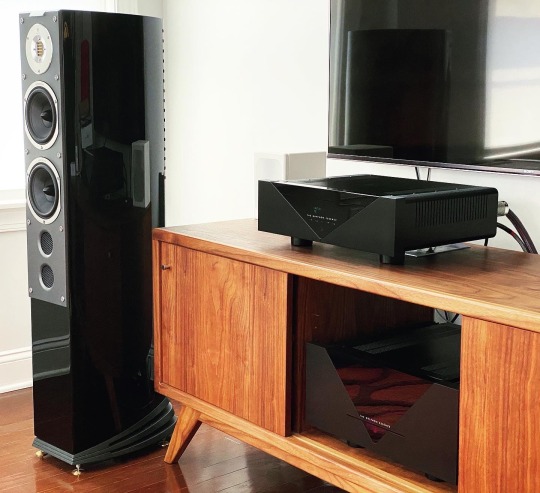
This brings me to another point: the SR 6 simultaneously strikes me as tremendously transparent, neutral and precise, but also possessing character. It's very hard for me to describe it any one way because the common sonic labels - warm, analytical, fast, full, forward, laid-back, smooth, sharp - just won't stick. Depending on the associated gear, setup and recording, any of those above descriptors could be applied to a very subtle degree, but switch up the source material and a different set of adjectives come to mind. Going to another abstract analogy, it reminds me of a delicious mineral water - so clean and crisp and pure, but not totally flavorless. The SR 6 is never bland to my ears; sure, a bad recording still won't sound great, but the presentation never falls flat. It has a fun and engaging take on music, perhaps due to just a hair of judicious boost somewhere in the midrange, that isn't dead-on neutral, but subtle and musically consonant. This is what I find most fascinating about Audiovector's tuning vs. other ultra high-end marques such as Magico or YG Acoustics, which can be breathtakingly transparent to the point of sounding flavorless, and incredibly demanding of source material. In those special moments with the right setup and recording they certainly could scale to greater heights of realism than the SR 6, but the Audiovector just sounds consistently natural and satisfying to me.
A few words on what this speaker is not. While it certainly qualifies as full-range, it does not have an overtly “big” sound. You won’t get the same sort of easy, larger-than-life presentation that a large-woofered speaker in a more classic mold (think a big old JBL with 15” woofers, or a top-end model from PBN or Legacy Audio) will give you. If you want Louis Armstrong to sound like he's sitting in your lap, or you’re trying to reproduce a club environment in your living room, there are better speakers for that. Bass extension is deep and powerful, but the quality of the bass that stands out is that it’s always focused - pitch, timing and weight are precise and balanced. It will convincingly represent a symphony orchestra, and the throbbing bass line of Billie Eilish’s Bad Guy will have you bouncing in your seat, but it’s not shake-your-walls, send-you-into-intestinal-distress kind of bass. It is easily the most detailed and revealing speaker I have had in my room, but it is never hyped-up, instead laying the music out for you to inspect at your discretion. The superb Audiovector AMT tweeter has a lot to do with this - it is free of the typical resonant modes of most dome tweeters and has resolving power well above the audible range, with none of the peakiness of metal domes that can go from vivid to fatiguing over time. There are designs with more natural warmth, that can make a female vocal sound more magically in-the-room and human - Silverline and GamuT are two superb marques that come to mind - but they might not be as neutral and versatile across many genres of music.
The Audiovector is much more precise and adaptable than speakers which blow you away with a particular aspect of their performance. It is the sort of sound that may not stand out as much in 3 minute sound bites at an audio show or dealer, but is more accurate and satisfying in the long term. And I appreciate how it effortlessly fills my open space with sound, but never overpowers it. This is a remarkably lifestyle-friendly speaker by high-end standards and I could see it working very well in a more modestly-sized room, though if you have a small room you are probably better off saving some money on the R 3 Arreté and putting the funds towards upstream gear.

The Take
As you can probably guess, I'm liking the Audiovector SR 6 Avantgarde Arreté a whole lot. A big speaker is always a risky proposition - you never know if it'll work in your room, reproducing a wider range of frequencies means more things to critique and potentially bug you, and of course there's the financial outlay. But so far, other than the need for extended break-in time, there have been zero frustrations and only delights in my experience.
As I write this, I'm listening to a lovely record of Bruckner 9 by the Royal Concertgebouw Orchestra with Daniele Gatti (Qobuz 24/96, Tidal MQA) at moderate volume. And I honestly have nothing to observe or say about the speakers because it just sounds good and right and I'm enjoying the performance. It's a total system effort of course, with contributions from PS Audio, Furutech, Audience and the transcendental Gryphon Essence pre + power amp, but as a music lover first and foremost I can think of no higher compliment for the Audiovector SR 6 Avantgarde Arreté.
1 note
·
View note
Text
A Tribute to Chester: Life, Death, Rebirth, and How He Lives on in Memory
How do you properly memorialize one of your childhood idols? Are you supposed to scream, cry, and gnash your teeth? Or do you put on noise-canceling headphones and block out the ambient noise of the outside world for a while? All of these are difficult questions to answer. I guess that’s why they’re rhetorical. It’s hard to believe that it’s been almost two years since Chester Bennington passed. So in a way, this simple little essay is how I can honor him. It feels nice to write something that isn’t fiction or related to a blog for a change[1]. Let’s see how it goes.
Part Zero: Notes from the Underground
I must confess that I was never a member of the official fan club, the LP Underground. I suppose in retrospect that’s how I could have proven I was a legit fan despite never seeing them live in concert except via live stream. But even then, that was a rare occasion. I do remember a t-shirt I got from Hot Topic when I was 12 or so – it had the faces of all of the guys gathered around the classic script font of the band’s logo.
I don’t remember what happened to it. The last time I remember wearing it was in August 2014. I supposed by then I had outgrown it. But still, buying whatever merch I could and getting all of the CDs and eagerly anticipating the next music video all had to count for something. I knew the names of all the guys, even Mark Wakefield, who was never an official member, and Phoenix Orion (Dave Farrell?), who left before Hybrid Theory but was back in time for Reanimation – more on that later.
But I digress. Let’s get on with the real meat of why we’re here. In terms of structure, I thought it would make the most sense to go album by album, discuss some memories I have associated with each, and attempt to unpack why they remain so important to me even as time has marched on since then. Growing up with the band, as I’m sure many of you did, you might feel a similar connection that you never fully grasped until the night of the tribute show in December 2017.
Part One: Hybrid Theory
#Forfeit the game/Before somebody else/takes you out of the frame and puts your name to shame/Cover up your face, you can’t run the race/the pace is too fast, you just won’t last. [HT Track 4: “Points of Authority”]
Although Hybrid Theory came out in October 2000, I think the first time I heard it was for another month or two after it came out. It’s still one of the most vivid memories I can still recall, the first time “Papercut” blared out of a cd player. I was sitting in the basement at my buddy Andre’s house and we were playing Perfect Dark with our mutual friend Alberto. It was honestly the perfect soundtrack for the game. Here’s what I said back then: “Dude, who is this? This is awesome!”
“It’s Linkin Park.”
Even then I thought the name was cool, the way that they intentional misspelled Lincoln – the rule of cool and all that. Elementary school hadn’t even ended yet, but it was still part of my formative years, musically speaking. Before then, I had never discovered any music on my own – my friends had always shown me. My parents didn’t raise me to enjoy music – I hated classical and most of the “standards” went over my head. My parents were still throwing karaoke parties. My old neighbor John showed me James Brown. That’s how I latched onto my first favorite song of all time “I Feel Good”. Then came Third Eye Blind, another early love of mine. But that’s a story for another time, as is my recollections of Limp Bizkit. This tale is about LP.
I wouldn’t realize it at the time, but Hybrid Theory would continue to be one of the most important albums to be me as I left elementary school and hit middle school. The days of Perfect Dark and WCW/nWo Revenge began to fade[2] as Diablo II and Starcraft emerged. The sound of Chester’s howls and Mike’s swagger along with the rest of the bands driving instrumentals provided a backdrop like you wouldn’t believe. “In the End” stood out in particular, although as middle school came to an end, it became clear that those reasons weren’t ones I wish to discuss here, now. Ask me again another time. It was at the end of middle school (hell, even before) that I confronted the notion of how deeply uncool I was, and probably tangled with imposter syndrome, anxiety, and depression long before I knew what any of those terms meant.
I already knew I was an introvert who was much more inclined to stay inside playing video games, reading, or writing instead of going outside to play street hockey or anything like that. That shouldn’t have meant that I was an easy target for bullying, but hey, it was the 90s and then the early 2000s, so what could you do? LP helped me cope, even if I couldn’t always express my anger in responsible ways.
I think here is a good place to stop and point something out: mental illness has been something that has been immensely important to me – it affects me and I know it damn sure affects my wife and mother in law. I went through a very dark time in my life roughly five years ago that LP also helped me pull out of – but I’ll get to explaining that more in-depth later on. Right now we’re still in the HT era; I just wanted to talk a little bit more about my motivations for writing this piece.[3]
Part Two: Reanimation
#Keep that in mind/ I designed this rhyme/ when I was obsessed with time. [RA Track 3: “Enth E Nd]
Full disclosure: when I first heard Reanimation, I thought it had its moments. But it wasn’t something I could listen to end-to-end and love every single song. Heck, even HT wasn’t like that, since some of the songs had to grow on me. The video with the robots and aliens having a war while the disembodied robot heads of the band sing the remixed version of “Points of Authority” by Jay Gordon of Orgy was definitely awesome, but I don’t know, I had mixed feelings about the album that took years for it to resolve into me think of it as one of the LP’s early era classics that would culminate with Meteora and Live in Texas.
I have a very distinct memory of popping this cd into the car’s stereo while we were out in…Houston? Taiwan? The details are blurry now because it’s been too long. Seventeen years was a long time ago, and 2002 me was simpler, less refined, and yes, much dumber and naïve. On an emotional level, “p5hng me Aw*y” stood out, and even though it wasn’t actually a true Linkin Park song, “It’s Goin’ Down” stood out from this time period too.
Part Three: Meteora
#I’ll never fight again, and this is how it ends…I don’t know what’s worth fighting, or why I have to scream, but now I have some clarity to show you what I mean… [MA Track 9: “Breaking the Habit”]
Meteora is one of those albums I more clearly associate with Diablo II and Starcraft more than any other games. Just something about the overall darkness and broodiness of the album really fit both of those games. Also, this essay project is making me want to go back in time. Not really from a nostalgia standpoint – okay yeah I guess from a nostalgia standpoint. But it was during this era that I really started to enjoy their music videos. Believe it or not, for the longest time, not all of the songs on the album were rated five stars. I used to be stingier with that rating that I am now. It took a while for some of the songs to grow on me, but “Somewhere I Belong”, “Faint”, “Easier to Run”, “Breaking the Habit”. “Nobody’s Listening”, and “Numb” were instant standouts. I’m still not sure what happened to my original copy of this album. The last I checked, I had a burned copy, but not the real deal.
Part Four: Live in Texas
#When I look into your eyes there’s nothing there to see/nothing but my own mistakes staring back at me# [LIT Track 8: P5hng Me A*wy – Live]
Man, I remember this too. It must have come out six months or so after Meteora did, and grabbing it from Kmart was one of my best days. I think it was also the first LP album to have the dreaded Parental Advisory sticker on it, and this is probably the album I blame most for me disliking the edited versions of songs. Sometimes edits can be clever, but when they’re just bleeps or certain naughty words are blanked out, then it gets annoying. Then again, I probably wasn’t a stranger to this concept thanks to early exposure to Third Eye Blind and Limp Bizkit, as I mentioned before. Was this the first time I heard “live” performances of LP? I think it was, and it probably stoked my eagerness to see them live in concert. Alas, it was never to be.
Part Five: Collision Course
#Yeah/Thank you, thank you, thank you, you’re far too kind# [CC Track 4: “Numb / Encore”]
It’s fitting that as I pick this up on (7/21/19) it’s the day after the 2 year anniversary. I meant to have this finished by the 20th, but it just didn’t happen. Plus “Numb/Encore” was one of the first songs that started up on this go-through of the playlist. If you’re interested in listening to it, I can direct you to my Spotify profile! Numb is one of those songs that have taken on new meaning since his death, but out of all the collaborations on this mashup album, I think it’s the one that works the best sonically and thematically, especially with the juxtaposition between angst and bravado[4].
Part Six: Fort Minor & The Rising Tied
#So sick, if he’s gonna think/That the good lord would come take him/I’m shaking him, “Wake up, you son of a bitch!”# [TRT Track 14: “Red to Black”]
It was four years between the era of Meteora and Minutes to Midnight. In between that time, there was a sea change. First there was the mashup with Jay-Z, and then this came along in November 2005. I remember being more stoked for it than probably any other music that I discovered that year – and this was when Fall Out Boy, 50 Cent, and Coheed and Cambria dawned on me, among others. For those who don’t know, Fort Minor is/was Mike’s side project. He’s since done other solo stuff under his own name but between then and now he would bust out verses from The Rising Tied and incorporate them into existing songs. I always thought that Red to Black was the most LP-sounding song on the entire album and that for the longest time I thought Chester used Jonah Matranga as an alias and it wasn’t a separate person.
Part Seven: Minutes to Midnight
#In this farewell/There’s no blood, there’s no alibi/Cause I’ve drawn regret/From the truth of a thousand lies/So let mercy come and wash away# [M2M Track 6: “What I’ve Done”]
In the interest of time, these entries are probably going to get shorter and shorter. At this point, I just want to get the damn thing over with. “What I’ve Done”, the lead single was the one that struck me the most at first; I remember LP making a big deal about how they wanted to start a new sound after leaving their classic era behind. The music video was awesome, and I think LP was one of the best choices for the Transformers movies. I always thought that “What I’ve Done” would make a great wrestling song. Not necessarily as an entrance theme, but as a hype video for a PPV or a feud or something like that. EWR back in the day helped reinforce that belief though I can’t exactly remember what I associated it with – anyway, that’s neither here nor there. The day that I got this album was the same day the shooting at Virginia Tech happened. Finding out that the shooter was a mentally ill Asian dude spooked me. In today’s parlance, I was shook.[5] That’s something that has always stuck out even though it’s something I’ve not been fond of discussing, for obvious reasons. Still, for our purposes here, it is for once, actually relevant.
Part Eight: Dead by Sunrise and Out of Ashes
#Don’t want to lose my innocence/Don’t want the world second-guessing my heart/Won’t let your lies take a piece of my soul/Don’t want to take your medicine# [OOA Track 2: “Crawl Back In”]
The melodies that emerged on Minutes to Midnight, especially when it was Chester’s turn to take the mic, evolved. They turned into another platform for his music: the side-project Dead by Sunrise and their only album, so far as I know: Out of Ashes. I lump this album in with Welcome to the Masquerade by Thousand Foot Krutch and Dear Agony by Breaking Benjamin. All three emerged during my sophomore year of college[6], which was another difficult year for me. I think that is when I had the most trouble sleeping, either by choice or for other reasons. Out of everything LP-related, I think I have given this the least amount of attention. It’s probably time for that to change, ten years later.
Part Nine: A Thousand Suns
#Now I am become Death, the destroyer of worlds/I suppose we all thought that, one another# [ATA Track 2: “The Radiance”]
If Minutes to Midnight was an attempt to step out of the shadow of Hybrid Theory, then A Thousand Suns represented an aural breakaway. It was vastly different, integrating more spoken word and turning up their signature sound to 12. I can’t remember exactly if it was in 2009 or 2010 that I was meant to go see LP as they rolled into DC. Ultimately, I couldn’t go because of a lack of transport. It all ended up moot anyway because that was the show that got canceled because of Chester being sick. Trying to dig up that post on Facebook is probably beyond me now because it’s a day late. Maybe someday I’ll be able to find it again because those days were golden (at least my pathetic little eulogy for him that I wrote two years ago.)
Part Ten: Living Things
#Fly me up on a silver wing/Past the black where the sirens sing/Warm me up in a nova’s glow/And drop me down to the dream below# [LT Track 6: “Castle of Glass”]
So if LP had been striving to break away from the sound that made them famous, it was at this point where they were “Nah bro” and went full bore back around into an ouroboros[7] of awesome. While the vast majority of A Thousand Suns[8] had to grow on me over the intervening years, Living Things grabbed me by the throat and never let go. It followed the Hybrid Theory blueprint to a T. After all this time, “Castle of Glass” still stands out as my favorite from the album, but as is often the case, it’s hard to pick favorites.
Part Eleven: Recharged
#When I was young, they told me, they said/Make your bed, you lie in that bed/A king can only reign ‘til instead/There comes that day it’s off with his head# [RC Track 1: “A Light That Never Comes”]
The less said about this, the better. It had its moments, especially “A Light That Never Comes” which showed me the potential of Steve Aoki. But the memory that stands out most clearly about the day I got this album was getting a case of Hell or High Watermelon beer. I think since I got it from Record and Tape Traders, it was the day I found the TARDIS socks for Ally and sent them to her later that week. As you probably gathered from the cluster of footnotes, this was deemed my least favorite “official” LP album, and that ranking has held up in the last six years. It does to Living Things what Reanimation did to Hybrid Theory, but for whatever reason, I can’t bring myself to enjoy it more.
Part Twelve: The Hunting Party
#Cause you don’t know what you’ve got/it’s your battle to be fought/until it’s gone# [THP Track 7: “Until It’s Gone]
Ah, here we go. LP seems to follow patterns in the creation of their albums. Cause roughly a year after Recharged, there came The Hunting Party. After A Thousand Suns came and went, it seemed like LP was on a creative lull. But then we got LT, Recharged, and THP in three straight years. This came out in 2014, and it’s hard to believe that five years have passed already. To this day, I still think that my favorite part was all of the guest appearances on their album, especially from collaborators they hadn’t featured before then, like Daron Malakian and Tom Morello.
Part Thirteen: Welcome
#First time I did it, yeah I’ll admit it/I kinda hit it and quit it and left y’all hanging# [“Welcome”]
In all honesty, this should be a footnote for The Rising Tied. It came out 10 years later, as a way for Mike to tip a wink and a nod at all his fans that were still waiting for a full-fledged sequel. Fate had other plans, though. I can still remember helping to clean Tidewater while this song blared through my headphones. This probably became one of my most played songs of 2015.
Part Fourteen: One More Light
#Who cares if one more light goes out? Well I do# [OML Track 9: “One More Light”]
We’re almost to the finish line. I was super excited for One More Light because it broke a drought of no new music until 2017[9]. The song One More Light became more poignant after his passing. I hope it still makes him proud.
Part Fifteen: Afterword
So where do we go from here? Honestly, not even the remaining members of the band know. They’re not actively looking to replace Chester, and as a group, they’re still officially on hiatus. I didn’t even touch on any of the DVD or special edition releases that I’ve barely heard. I guess in a sense they’re honorable mentions, but without having listened to them, I can’t form any honest opinions or associations for them.[10]
[/mrhahn]
[1] It seems fitting that I mention that shirt I got as a twelve-year-old because that’s when I started picking up on writing as a hobby. It was a way to release my imagination and translate what I had in mind into a story, even if those early stories were embarrassingly bad. These footnotes will serve to flesh out those asides since they’ll more than likely distract from the main narrative I’m trying to spin here.
[2] Although Revenge remains iconic! Even to this day, I still long for an N64 and another copy.
[3] Chester struggled with MI too, even though hardly anyone knew it. It’s what ultimately got the best of him.
[4] My fascination with Genius Lyrics is really helping me to analyze and better understand the meanings of the words.
[5] It didn’t help that he bore an uncanny resemblance to me…
[6] 2009, how time flies!
[7] Not sure how to spell this dang word.
[8] I regarded it as my least favorite LP album until Recharged came out. More on that later.
[9] It wasn’t until that I built the playlist that inspired this essay that I learned that there were some other singles issued between The Hunting Party and One More Light. These tracks include “We Made It” with Busta Rhymes, which actually fell between Meteora and Minutes to Midnight; “Not Alone”, which was between A Thousand Suns and Living Things; and “Darker Than Blood” with Steve Aoki that was between The Hunting Party and One More Light.
[10] One was called “Frat Party at the Pankake Festival” and the other one was “Road to Revolution”, I think?
2 notes
·
View notes
Text
I love horror, I just have impossibly high standards
anyway some of my favorite is the kind that is totally normal from the start, there's nothing off kilter or weird, everything is fine. it's mundane. but then maybe something strange happens and it's less mundane, maybe it's more colorful or lively. but it's not like it's scary or anything. maybe it's a little left of center but it's still fine. life goes on as normal.
but then suddenly it's not fine.
and it recontextualizes everything up until now and you realize oh my god it wasnt mundane at all, it was just pillars of foreshadowing and you realize this is the most terrifying thing you've ever encountered.
maybe it goes on with the weird scary shit and things resolve themselves later, but that gives you time to breathe and get accustomed to the horror.
maybe it just ends. maybe it's just suddenly "surprise, shit is fucked!" and then ~fin
that would be ideal. like, in the sixth sense, you find out Bruce Willis was dead the whole time, you see him making peace with his death, and then the movie ends. except without all of the overreliance on shock horror and the visually disturbing (for the 90s) shots of the entire rest of the everything.
but if the twist happens at the halfway point and things stay absolutely horrible for a while that's also good, like coraline. started off pretty normal, got a little weird, and then suddenly boom ITS HORRIFYING OUT OF NOWHERE.
a perfect example of the last line twist would be the girl with the green ribbon on her neck. aww the boy likes the mysterious girl and they fall in love and get married, really normal the entire way. and then oh surprise HER HEAD COMES OFF. simple yet effective.
I don't mind if it starts out the gate with being seven levels of fucked. dead space 2 opens up with nicole, narratively speaking just moments after she end jumpscares you in the first game, so we're already off-put. then 60 seconds in we see isaac in a straitjacket being questioned and in the background there's flashes of being on the ishimura and nicole's ghost walks up to you and slavsquats and her eyes light up and she whispers, then SUDDEN WHITE oh cool it's ok look it's franco from dead space ignition that's cool aww he's saving Isaac oh wow it's a really creepy atmosphere OH MY GOD IS HEAD IS GETTING STABBED AND HIS FACE TURNS INTO A GODDAMN ZOMBIE HOLY SHIT THEYRE EVERYWHERE RUN BITCH RUN CHAOS LOUD MUSIC BLOOD GUTS FEAR QUICK MASH THE A BUTTON OR DIE!!! oh everything is quiet now. good job you survived, now walk down the corridor to the next intense scary part. lather rinse repeat.
I like horror when it's well executed or creative and not schlocky and relying solely on savini's gore or unnecessary carnage.
friday the 13th is like, oh wow that person just got an axe in their forehead, I sure am quaking in my boots. oh wow the tall stuntman picked up a sleeping bag and slammed it into a tree, this sure is realistic. oh the scantily clad teen girl is running slowly through the forest while cain hodder slowly walks towards her, and he somehow catches up and stabs her with the machete. wow the effects sure look like foam core and wax got cut in half and is squirting ketchup everywhere. the music is sonically engineered to force my pulse to increase and I guess this is horror? oh look someone else got murdered. oh look another murder. I'm sure glad we spent the first 45 minutes of this movie getting to know the shallow garbage characters before they all get merced. wow crispin glover sure does know how to shake his head when a prosthetic attached with fake blood is on his head. oh look a dead body with arrows in it, the scream queen is piercing my eardrums, I guess this means I should be scared too. yawn. it's so fucking boring just watching people die over and over again. at least the later installments were either hilarious or batshit crazy. punching a dude's head clean off was the funniest thing I've ever seen in a movie given the context, and JASON GOES TO SPACE is the dumbest shit in any film but that's what makes it awesome. it had a stupid fucking robot fight. yet everyone hated it, so they rebooted it and surprising literally nobody it was the same shit but with more cgi so it looked even less real (not that it did in the first place). yet this franchise made hundreds of millions of dollars in ticket sales alone. nowadays there are people who see hockey on tv and ask "why the fuck is that guy dressed up like jason voorhees".
tell me why a free swedish gold source mod with blocky graphics and muddy textures and the worst lighting engine in 20 years and some bad questionable design choices in an almost direct ripoff homage to silent hill 2 and resident evil 2, crammed with bugs and bad collision and hard crashes if you die in a specific level while holding a flare which you literally need to always have lit because that's the mechanic the entire level was built around, by a team of like 6 people (half of whom were the voice actors and navmesh modelers), is still one of the best and well-crafted pieces of horror media I've ever consumed, while trash like the fucking craven-less elm street remake gets its dick sucked by everyone else because OH WOW ITS SO SUBVERSIVE AND EDGY AND GORY WOW COOL THIS IS REAL TRUE HORROR!
of course I'm approaching this from a purely american lens. japan's horror is phenomenal. mainly because it's not built around buckets of blood and literal pig carcasses and abusing actresses and actual rape scenes (although it's funny that people are totally okay with all of the graphic murders because killing people is okay and indulging in torture porn is fine but oh, god forbid a film shows something skin-crawlingly uncomfortable for the sake of making you feel disgusted and wanting a cold shower, no, the line is drawn there, you can stab a naked girl with a power drill or drop a chainsaw on her body and that's fine but if a snowman slams her body into a wall while his carrot nose is inside her hoohah that's when it's going too far? seriously? whatever I've beaten this dead horse). but eurocanadamerica's obsession with gore porn in horror and blumhouse's shitty jumpscare factories have reduced it to just... loud noise, stabbing, loud noise, stabbing, lather rinse repeat. this is horror now I guess.
nobody takes coraline seriously as horror. nobody takes the green ribbon seriously as horror.
the monster chasing you isn't horror. it's terror. horror is when you step on a bear trap while the monster is chasing you. the monster chase without the bear trap has no impact, it's just "watch this person fear for their life and die". yeah, if I wanted to watch a snuff film I'd look outside of mainstream markets. "oh but if it's just a movie it's not real" so says the people who suicide bait cyber bully and harass teens who ship a 17 year old with a 19 year old, or two people who work with batman, all over fictional alleged pedophilia and incest. because it's all bad unless it's violence. only sex is bad but not violence.
the violence cannot stand on its own. it needs to have narrative purpose. resident evil, all of the zombies and monsters were bioweapons being manufactured by a corporation. silent hill and cry of fear, all of the monsters are just the embodiments of the protag's inner demons. dead space, the batshit crazy religious cult wants to turn everyone into the undead since that's their idea of heaven, and you have to fight them and stay alive so you can prevent the universe from getting omnomnommed by the blood moons. f.e.a.r., a little girl with some psychic powers is studied, tortured, abused, and :/ raped (at least you don't see it) and she naturally responds by lashing out at the ones who hurt her and trying to reunite with her baby, who is... you! (spoilers).
what is the plot of friday the 13th? dumbass kids get drunk and have sex and let a little kid go missing and his mom has a psychotic break and starts killing them all, then they kill her and the kid kills more people and then he kills more people and then he dies and comes back and kills more people and then he dies so someone else starts killing people and then jason comes back again and kills more people again and he gets arrested and they try to execute him but he won't die so they cryogenically freeze him until he kills people in the future, and in a different timeline he kills people and fights freddy krueger. it's pointless. popcorn. drivel. there is no narrative purpose, it's just murder for murder's sake. and that's scary???
like I said. impossibly high standards.
I love horror. but holy shit is a lot of horror bad.
0 notes
Text
My Series 10 Rewatch: The Return of Doctor Mysterio

Ah, another Christmas episode. How many is that now? Two in a row? If you’ll recall from last time, I remarked that the only thing I liked about Christmas episodes was that it was more Doctor Who. While I will admit to a degree of hyperbole, it wasn’t far from the truth. Which is why "The Return of Doctor Mysterio," is such an interesting follow-up, as I have a "second" reason to like Christmas episodes. Only in a Christmas episode can Doctor Who get truly stupid. I’m not saying I hated it, I’m not saying I liked it, but I think I loved it.
"The Return of Doctor Mysterio," is very much a stupid episode. But in the same way, a child can believe in a jolly fat man delivering presents every year, Steven Moffat asks us to believe in a Doctor Who where Superman could exist. It doesn’t fit the tone of the show, and it’s not even particularly topical. The idea of superheroes in the media is so cliched, that it’s cliched to even point that out. It felt a little dated even at the time it was made. So how has it given me a newfound love for Christmas episodes? Because it plays its hand at the right moment. Doctor Mysterio could only ever work on Christmas.
We open on the Doctor swinging outside a young boy’s bedroom window on Christmas Eve. The Doctor has been up on the roof of the New York skyscraper this boy calls home. After climbing into the window the Doctor introduces himself to the boy whose name is Grant. He explains that he was up on the roof building a machine to fix space-time distortions created by his own meddling. Think back to stuff like the weeping angels turning a hotel into their own food pantry of Rory-O’s. It’s a classic Doctor Who machine made out of various bits, making very little logical sense. It doesn’t matter though because the Doctor is in possession of a McGuffin named the Hazandra, a gemstone also known as "the ghost of love and wishes." Basically, it’s Christmas magic a convenient polyhedron. With it, his machine should stabilise the distortions.

Young Grant and the Doctor’s interactions in this scene are a great example of Capaldi’s charm as the Doctor. I love the Doctor not knowing Clark Kent and Superman being the same person is common knowledge. It scans with his not knowing there was a film called "Alien." The Doctor doesn’t need to know everything all the time, Chibnall. I find everything about this scene completely believable in its context. There’s a brilliant exchange where the Doctor produces a glass of water from his coat for Grant’s cough. After being handed the Hazandra by a man going by "Doctor," he assumes the Hazandra is medicine for his cough and gulps it down. I find it a little hard to believe that a geek like Grant didn’t at least question if it was a D12 first. He seems like the kind of kid who has done some tabletop gaming. Having taken a heroic dose of Christmas magic, Grant starts tripping out like he can fly and shit, which he does, because wishes. Realising the only thing to do is wait for the gem to pass through his digestive tract, the Doctor bides his time. I like to think that somewhere for about a week, the Doctor was scanning the plumbing of that building with his sonic screwdriver. "Still nothing."
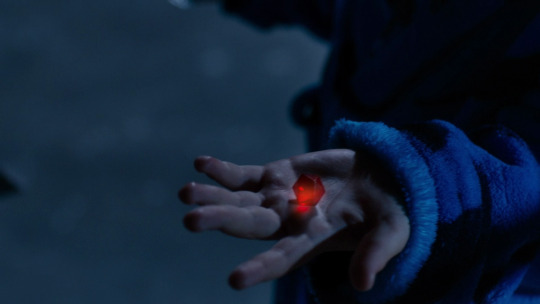
With Grant’s body refusing to give up the ghost, his superpowers grew more powerful. This, of course, brings us to present day where Grant is now mild-mannered manny and Super Saiyan "Goku," noted by the G on his chest. No, wait, wrong franchise, it's the Ghost, not Goku. Not since "The Mind Robber," has Doctor Who taken on the concept of superheroes quite so directly. But, unlike Karkus, the Ghost is not meant to be a man from a comic book. Though everything about him is directly from a comic book. The Ghost’s powers are a little boy’s wishes given form. I’ll admit that while wearing my Doctor Who cosplay, the coat does tend to blow in the wind like a superhero cape. While some will even agree that the Doctor is a sort of superhero, even the show recognises its own limitations in this department. Seeing a caped vigilante standing next to the Doctor is weird. It’s wisest to treat this as an anomaly.
Moffat is in no way shy about playing into some of the biggest comic tropes. When we meet Lucy Fletcher, a reporter for the Daily Chronicle, she’s an obvious homage to Lois Lane. So it’s easy to assume that the people she’s investigating, a corporation known as Harmony Shoal, are some sort of villain. It’s also a reminder of the influence of comic books on classic characters like Sarah Jane Smith or Donna Noble. Also in attendance is Nardole, seemingly reunited with his body. After some pointed questions about missing executives from Ms Fletcher, the press conference ends with Lucy unconvinced by their answers. She decides it’s best to stay behind and investigate. As do Nardole and the Doctor.

It’s a testament to how little I remembered within the year between these two Christmas specials, as I didn’t even remember that the Shoal of Winter Harmony were a Doctor Who baddie. Hell, I didn’t even remember it years later when I watched "The Husbands of River Song. If you’ll recall, I went on to complain that they were underdeveloped. Well, I guess I got my wish because here they are again. This time around we learn that the Shoal are a group of brains that look for viable hosts to live within. They open up the heads of humans and replace their brains. I’m beginning to see why I forgot these were the same villains. One is a bunch of brains in a jar, à la "The Keys of Marinus," while the other is a group of people able to open their seemingly hollow heads. Like, do the brains open up when they open their heads later? Why do they open at a diagonal layer when the brains clearly have a vertical hemisphere? Their physiology is a bit perplexing, even by Doctor Who standards.

While discovering the Shoal’s secret, Lucy meets the Doctor and Nardole, who are also spying. After witnessing one executive transplant an alien brain into the body of another executive, the three of them are captured and held at gunpoint. It's at this moment when we first see Grant as the Ghost, as he saves the trio using super-heroics. After whisking Lucy back to her apartment in a classic "superhero saves the girl," manner, we learn that Grant is actually Lucy's manny for her baby. This explains why he was watching out for her, and how he found her home so easily. The Doctor, having used the TARDIS to track the Hazandra, is already at Lucy's apartment waiting for Grant to chastise him for using his powers. Lucy believes the Doctor is there for her causing both her and Grant to lie to one another about how they may or may not know the Doctor.
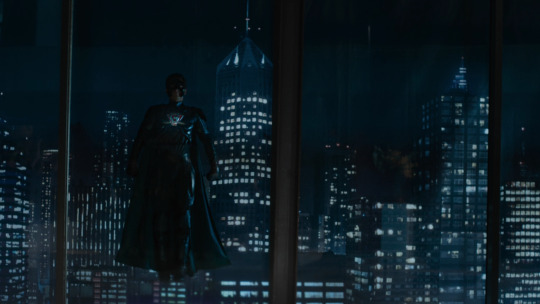
Now, I would like a minute to talk about the costume. Basically, it's not very good. In fact, it's kind of bad. I don't mean to badmouth somebody's hard work, because it's not the craftsmanship I'm criticising. It's barely even the design. It's the reason for the design. You see, the Ghost has an awful mask. It covers about 75 percent of his face and is basically like no hero mask we've ever seen. The reason for this is that despite all of its whimsy and Christmas magic, the idea that a pair of glasses is all the secret identity a hero needs is too stupid even for Doctor Who. Hell, it's too stupid for Superman. Lois Lane is a Pulitzer Prize-winning journalist, and she's thwarted by a pair of specs? Seeing them make up for it by covering Grant's face in an awkward plastic mask just highlights how poorly Doctor Who and capes mesh. Except in the case of Jon Pertwee.
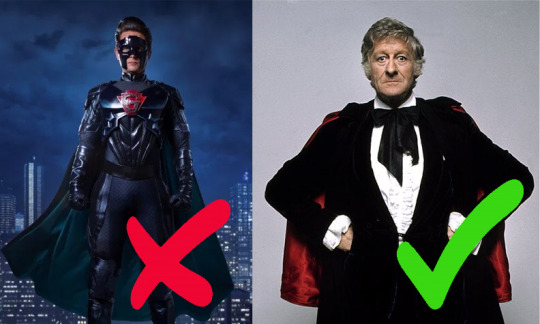
Lucy and Grant have that classic Clark Kent, Lois Lane, Superman, love triangle going on. Or Jerrica, Diego, and Jem if you're not a comic book nerd. It's the whole "Does she love me, or does she love him?" trope. All that's left is for Grant to do one of those two dates at the same dance scenes and we'll be set. Oh, they do that later on in the episode? Oh. But that's getting ahead of ourselves. Let's talk about that interrogation scene.
In 2012, "Zero Dark Thirty," came under fire for its apparent glorification of torture during interrogation. Which seems a weird takeaway if you've actually seen the film. However, the point was made- torture is inhumane. Which is why I must warn those of you with a gentle constitution that the torture scene of Mr Huffle is brutal. Every time Lucy adds pressure to this poor man's head, he cries out in agony, and she knows it will work. The Doctor is unable to stand the idea that another need suffer that he might keep his secrets, so he spills the beans. Of course, I'm kidding, the scene is absolutely ridiculous, but it's also kind of cute. It's yet another of those moments only afforded by Christmas magic because anywhere else it would be stupid. I just want to know where Moffat hides the giant bollocks required not to edit that bit out.
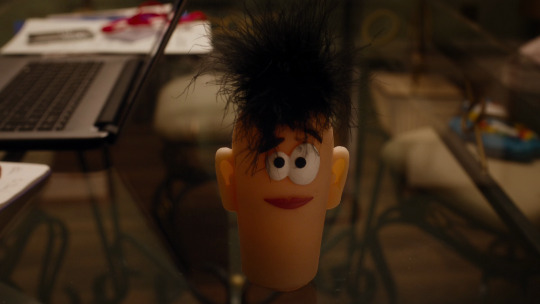
Now, remember how I said in my review for "The Husbands of River Song," that the baddies never really had much development? As it turns out, they're not all that deep. The main goal of the Shoal (Judoon on the moon), is to fortify their headquarters to survive a massive blast. Their reasoning is that when their ship impacts with the planet, their building will remain standing among the rubble of New York, acting as a beacon to the world's leaders who will flock to them. This way, the Shoal can take over the bodies of leaders. It's a dumb comic book idea in a dumb comic book episode. If their building attracted anything other than droves of survivors, it would most likely attract the attention of investigators. "Oh hey, maybe we should investigate the people who battened down the hatches immediately before the blast." Nothing fishy there. A foolproof plan. Because comic books, and Christmas.
Please don't mistake my tone for derision. I genuinely think Moffat made the right decision in keeping the plot a bit campy. It absolutely fits with the theme of the episode. This doesn't mean that the premise doesn't wear thin. It does so with so much haste that the promotional photos began to feel hackneyed. I've said in the past that Doctor Who is very much like a comic book, but even then it's a completely different genre than superheroes. The idea of the Doctor and the Ghost teaming up seems more appropriate for the comic pages of Doctor Who Magazine. And even then it would feel silly. You would see it come up on lists titled "Top Ten Weirdest Moments in the Doctor Who Extended Universe." It's up there with "Combo Man" or "NFL Superpro," in that it's a pale imitation that does nothing to add to the genre. The fact that they made a Ghost spin-off comic book is mind-boggling.

The Ghost fits very uncomfortably into the Doctor Who universe. Hell, he fits uncomfortably into New York. I did the math, he was old enough to stop 9-11. Or at least save some people. It's one of those "This is why the Doctor doesn't travel to the holocaust," things. It's just easier to ignore a real world tragedy. But even within the Doctor Who version of New York, the episode raises a few unanswered questions. Ever since Amy and Rory "died," the fandom has questioned why the Doctor didn't simply travel back in time to save them. Moffat's response was that the events of "The Angels Take Manhattan," made New York too chaotic a place to land. So the fans said, "What about taking a taxi into New York after landing safely outside?" To which Moffat said "Ah, but the tombstone! It's a fixed point in time." Which is a good point. There's no way you could possibly fake a tombstone. Those things are counterfeit-proof.
The point I'm getting at is that New York is all sorts of messed up by the Doctor. As I stated earlier, it's the whole reason he was there in the first place. The problem I'm having is that if the Doctor brought the Hazandra to New York to repair the rift, and Grant swallowed it like medicine, what the hell repaired the rift? How is the Doctor able to visit Lucy's house? How is the Doctor able to travel to and from the Shoal's ship orbiting the earth? If the Doctor can pilot the TARDIS in and out of New York City, what exactly needed fixing? And if nothing needed fixing, why then are Amy and Rory dead? And it wouldn't be a big deal if Moffat hadn't literally made it a plot point in the first place! That's two episodes in a row now where Steven Moffat introduces a concept only to completely go against it later on. Maybe he knew he was on his way out and he started phoning it in because I know Moffat is a better writer than this.
Ok, so where are we in the story? It doesn't really matter. Basically the Ghost and Lucy have dinner on top of Lucy's building. But it's when talking to the Ghost that Lucy realises she loves Grant. At no point does she not realise she's an idiot unable to see through a very dumb disguise. The Doctor and Nardole have jumpstarted the Shoal's plans by crashing the ship themselves. This forces the Shoal to act ahead of schedule. Also, for some reason, the Shoal seems to think they would be able to take over the Ghost's body. I guess superhero skin is one of those things famously known for being fragile and easily broken. Surely there's no flaw in this plan whatsoever. Grant uses this as an opportunity to switch out of his cape in back into manny mode. Acting as the hero, he swoops in and saves the day. Not only does he thwart the Shoal, but he also one-handedly catches their ship before it can make impact, thus saving all of New York.

The Doctor alerts UNIT to the Shoal's activities and before they can make their break are apprehended. All except for a single Shoal who has taken over the brain of a random UNIT soldier. It's one of those comic book cliffhangers that will fall apart if you start to think about it. I'm going to say it's absolutely acceptable in these circumstances, but I am absolutely still going to pick it apart. Like didn't the Shoal say earlier that they require a suitable host? What constitutes a suitable host? Did they mean suitable as in "a person in power," or was it a blood type thing? Do some people's bodies reject their new brain? Furthermore, didn't the Shoal keep creepy surgeons in closets for this kind of operation? How then is one of them able to do complex surgery in the span of moments? As I said, it falls apart.

"It falls apart," is the theme to this episode. In fact, the entire plot hangs on the premise of stupid comic book cliches. Nothing about this episode works as an episode of Doctor Who. But, as I said, it does work as a Christmas episode. In that way, it makes me both love, and continue to hate Christmas episodes. In the same manner, I admire its frivolity, I also loathe its crudeness. I'm not exactly running out into the streets like Ebenezer Scrooge asking what day it is, but I'm not saying "Bah! Humbug," either. Let's just say, I'm glad the next episode in this watchthrough isn't a Christmas story. The only thing worse than watching two Christmas stories in a row is watching them while in lockdown in July and August. There is neither anything holly nor jolly about this season.
The important takeaway is that I actually found myself having more fun this time around. Perhaps it was the fact that I now knew what to expect. The idea of a Doctor Who superhero episode can't be as bad as it already was. I've found this to be a common theme in revisiting a lot of Doctor Who. Without your initial expectations in the way, fun can sometimes peak its head in and say hello. Which is why I said I loved this episode. It wasn't good, but it was fun. I even got to see this play out in real-time. My boyfriend who had either never seen the episode, or forgotten it completely, spent most of his time hung up on how stupid the premise was. While I was actually able to spend more time appreciating the performances. The superhero tropes seemed less tired, and more like a necessary function of the narrative. Sometimes there is virtue in knowing something is going to be shit.
Hey friends! Thanks for reading this far. I wanted to pop in and apologise for how long this took to post. Last week was my birthday so I took the time off. Also, for some reason I was really dragging my feet with this one. Go figure. Next time, we say hello to Bill! See you soon!
#doctor who#the return of doctor mysterio#steven moffat#twelfth doctor#peter capaldi#nardole#matt lucas#christmas#series 10#the ghost#bbc#tardis#rewatch#watchthrough#harmony shoal#Time and Time Again
0 notes
Text
Sonic Forces Review — It Wears Its Heart On Its Sleeve
Sonic Forces, an interactive movie with some short puzzles and reflex challenges. It’s the junk food to it’s four-course partner, Sonic Mania, but that isn’t a bad thing.
youtube
**SPOILERS AHOY**
Now, this is not a derogatory usage of “Interactive Movie”. But after completing Sonic Forces, this is kind of how I interpreted it. It’s something that has it’s appeal, but in modern gaming conventions doesn’t really fit in.
During my time, I kept thinking back to Asura’s Wrath — a game that was more like an interactive movie, kind of dubbing it as “Anti-Game”.
Like Anti-Film, Anti-Game tries to break and subvert the conventional definitions of a game, and as I journeyed through it, I started to interpret Forces as a bit like that. But I realized I was thinking way too hard and just found a lot to enjoy about Sonic Forces in it’s off-beat nature and spectacle.
In fact, I was about to do an active study into thinking whether Modern Sonic as a game series is Anti-Game in it’s own right or not...
My reasoning was factoring Sonic Team’s constant experimentation and liberative design philosophy — in where the games can change up in an instant to play against any established status quo. But I realized how hyperbolic that was and there was just not enough information readily available to articulate for or against that notion. In the end, it’s up to the individual’s interpretation. But man, it was an interesting hypothesis to the state of gaming and Sonic being a rebel, just as he was in the 90’s...
But anecdotes aside, let’s dive in an see what Sonic Forces had to offer...
Firstly, what I liked.
The Avatar: I felt that a lot of love was put into the idea of the Avatar and their stages have the most in terms of experimentation with different Wispon power-ups and junctions of exploration, even if the levels themselves were relatively short and some Wispons *coughcoughDRILLcoughcough* can be frustrating and poorly implemented.
Music: Seeing that Kenichi Tokoi was a main composer and his soundtrack from the Sonic Riders series could be felt throughout Force’s energized, electronic soundtrack. It feels like a very different soundtrack for Sonic and one that I felt was welcomed. I personally loved the Avatar OST, which had a blend of electronic drum and bass with lyrical tones that created something very different than standard fare.
youtube
The Story: While fan-fiction levels of cringe — especially in execution, it had an interesting point of character development for the newly implemented Avatar. You see the character go from cowardly civilian to a hero standing beside Sonic. Something about that made me warm up to the custom character and what they had to offer. I also really enjoyed the connection to Mania, making them what I called Phantom Ruby Saga.
Shadow DLC: While short, I really thought Shadow’s story and level-design is more along the lines of what I wanted Modern Sonic to be. The story is your edge cringe of Sonic’s yore, but it was enough to make me laugh and admittedly, the last part caught me off-guard.
Next, what I didn’t like or found problematic.
Classic Sonic: Just frustrating. I didn’t like him much in Generations and Sonic Mania did him so well, that it really showed how I’d prefer Forces without Classic Sonic. A more balanced focus on Modern Sonic and the Avatar could’ve made it stronger. I think I’m just sick of Classic Sonic, and ready for Sega to let him go.
Modern Sonic: Rather uneventful. He was more fun than his classic counterpart, but overall the Sonics felt like less of the focus compared to the Avatar. I enjoyed the sprints of Sonic and the reflex challenges, but it wasn’t anything to write home about. Once again, I feel that ridding Classic Sonic from gameplay would allow more focus on Modern Sonic’s spurts.
The Story: Overall, it was not for me. It felt like it was going to a Sonic Adventure 2 place with this goofy story but dark atmosphere looming, but it started taking itself too seriously that it became campy and cringey. And in execution, it got a little ridiculous when there is a “War” scene which looks more like an amateur Machinima film.
The Bosses: A bit of a mixed bag, with most of them being short and repetitive. I did enjoy the Avatar vs Infinite boss, his powers and noticeably trippy aspects made it quite the difficult fight to figure out and once I figured it out, he wasn’t too much of a hassle. Kudos, goes to the Death Egg Robot, only Mania has been able to make that boss fun.
But the main point of this review is the point of contention for everyone on all sides:
The Gameplay and Level Design
Honestly, the levels are short — most lasting about 2 minutes. For many people, that’s too short and I can see where they are coming from. After the healthy bulk of 9 levels with 2 Acts in Generations to 30+ short, concise levels was a major departure. Though, I feel game length is not really a credit to a games benefit or detriment. It’s just the length of the experience. And personally, I liked having 30+ short mini levels that had their own little gameplay gimmick to mess with than 4-8 minute levels that just go on. Both have merits in different ways.
To that point, I didn’t mind the length with the Red Rings returning. Showing that I missed things and can go back — I feel that shorter level design in Sonic works better when it has hidden goodies. But that’s just my opinion, they can be linear and a bit over reliant on spectacle and QTEs but I’ll say that I didn’t have to care about QTEs since you can just mash them and make it through, they are not really invasive. Now, if a death depended on my skill at a QTE, I’d be more frustrated — but it was not for me. So I’m indifferent to the QTEs in Forces.
My favorite levels were most definitely the Metropolis City with the Avatar and the Death Egg Level with Modern Sonic. It was a lot to take in and kept me guessing to figure out how to survive the tight platforming and reversed physics as well as just having a fun little spectacle for a minute or two is fine by me.
... But in summation, I feel Sonic Forces just wanted to be a spectacle. It wasn’t trying to be the next revolutionary title for Sonic, but a fun, arcade-y romp with your own character and Sonic. Each level being a short puzzle to figure out where to go and what to find and concluding.
— And that, I think it does a good job at just that. I found that somewhat charming.
If you’re expecting something deeper or to get you into Sonic — stick with Mania or get Mario Odyssey. If I were to compare them, Sonic Mania and Mario Odyssey are the stronger of the three games. Mania’s more tightly designed in gameplay and level design and Odyssey is more open-ended.
However, Sonic Forces wears its heart and intention on it’s sleeve and knows what it is. It will have it’s die-hard fans and haters — and that’s OK.
It’s got a $40 price tag and I felt that I received $40 experience, along with the free DLC from Pre-Order. I’m not one to judge a game as good or bad based on my own opinions. I can only weigh the pros and cons of my experience to create an interpretation — and Sonic Forces let me do that and be satiated. If you’re a Sonic fan, you’ll probably like it.
If you have $40 to blow and and are curious, give Forces a shot. I like that it knows what it is and it was enjoyable romp for me. Or if you have $60, get Mania and Forces — play them back to back.
Sonic Mania is like a full course meal and Forces a dessert, you may be too full for dessert or not a dessert guy, but taste it and see how you feel. The two complement each other in this way that I can’t explain in words other than Antithesis — it’s a satisfying feeling that left me full of Sonic for the year.
I have a hypothesis before we go. I was wondering that with the lower price tag, did this game had a much lower budget compared to it’s older siblings? It doesn’t feel unfinished, or rushed but something that was weighed down by factors be it a newer dev team or a lower budget. Either way, it was ambitious with the Avatar design and that I can appreciate from an outsider looking in. Perhaps with more time, I’ll get more information about the development cycle. It’s just a hypothesis and my interpretation of it all.
In conclusion, Sonic Forces truly is a B-Movie experience wrapped up in a Sonic game, and it’s enjoyable for fans or people wanting to see what Sonic is up to. Nothing spectacular, but nothing awful either — Just a cute way to kill some hours.
I’d love to see what Sega can do with the Avatar and Modern Sonic in the future, and see them try things iin a more avant-garde manner. Sonic has always been a bit of an oddball, off-beat series that I’d love to see taken to an artistic extreme. This felt like another step in Sonic’s never-ending journey to continue forward. I’m beginning to wonder if he’ll get more off-beat as time goes on.
Anyway, I need to go back to Persona 5 and break more chips into that thing! I know, I’m very behind, I just got to the second palace... sigh...
Always bloom proudly, guys!

— TUCHI OUT!!
#sonic the hedgehog#sonic forces#review#interpretation#sega#sonic team#video games#critique#analysis#sonic mania
2 notes
·
View notes
Note
Hi Father Claude! (If it's okay to call you that?)This is going to sound silly, especially since we don't really know each other, but I've followed you for a while and you seem to be pretty versed in art-for-hire, I was wondering if you could help me out? Someone messaged me (across several accounts on different sites) about an artwork of one of my OCs asking if they could use it for a logo. I said no but I'd be happy to work on a commission for them -- how do I determine what a fair rate is?
2- I don't really do art for a living, just a hobby (I know it sounds cheap when I put it like that...) so I don't want to shoot myself in the foot, particularly since by the sounds of it this person wanted to use this for branding purposes and that's pretty major. I'm both a little flattered and a little overwhelmed, so...you know, how would you negotiate something like this? How would you determine an acceptable rate (either hourly or a flat fee? I'm not sure which is better)?- Sorry for taking up 3 asks for 1 question but you seem like you have experience with this, and I'm used to deferring to experts for matters I don't know much about! Any advice you could give would be greatly appreciated. Thanks!
Yeah sure and oh that is tough! So you got someone who needs a brand logo and you wanna know what rate to quote him at, yeah? First, congrats! Second, well I don’t know too too much about logos and other specifics of graphic design branding freelancing as I didn’t go that route professionally but I have done book covers, illustrations, and comic work so I guess I’ll speak from that. Please note that I don’t do this full time or even much part time (though I might soon enough if I return to school fulltime) so this is a tad laid back in nature. Someone who does this professionally might be better equipped to talk about this.
If I were in your shoes, the first thing I’d do would ask about his budget -- what’s his budget and what is he willing to work within? You ever hear the phrase “the first person who mentions price loses?” Yeah, so find out where his budget is. Next, compare that budget to both the industry standard for the product (which’ll take some googling or asking around) and to what you’d be willing to charge (which should be based on a mixture of living wage, time it will take to complete, skill, supplies, and other). For the record you can also be doing that step while you send off the “hey what’s your budget” email because it’s always good to have that in mind. If he asks your rates first a decent response is always “well that changes based on what you want and the complexity of the design; a budget would best help me figure out a logo solution that won’t break the bank” or something.
If the budget looks doable, I’ll give him my quote for the project and my terms and if he agrees to them then I’ll write up a contract. I’ve often based my contracts off of the ones on Art Pact which offer free templates. Contract time is where all the negotiation begins and you can stipulate price, whether the client will cover Paypal fees, when you’ll get it done by, and so on and so forth. It’s always good to have a contract because if you’re not working as part of a firm or whatever the contract is a way to CYOA (hell even my boss and I signed and informal contract and when I send them invoices I always specify that such and such fee is there “as discussed in our correspondence” or somesuch just to, again, CYOA.
So for example, if someone came up to me and wanted a logo done for let’s say their startup coding company -- nothing fancy, just a name in perhaps a decorative fashion, easily applicable to say a website or an invoice -- then first I’d write them back asking for their budget and maybe a little info on what they need it for, what their plans are, etc. You don’t wanna be charging pennies for the next Warner Bros. logo, y’know?
Then while waiting, I’d research the industry standard for logo designs -- what’s the general rate, what are people asking, what are newbie freelancers asking, what’s the range, what should I be charging? I’m lucky in that my best friend works in a print shop and does logo design so in theory I can ask her but let’s say she’s at church and I need an answer before Communion, so I’m gonna google “industry standard logo design”. Deluxe Corporation gives a few figures and an idea of what you’re paying for and why but no less than $200 seems to be the oft quoted number. So the industry standard is at least $200.00 USD.
Now the question is what’s my standard? Well I refuse to work for under $15/hour minimum, I have over a decade of doing art in a public sphere, longer still of doing art in general, and about 7 or so years on and off of doing art for pay and in all that time I’ve become familiar enough with some programs, have a handful of resources font-wise and other, and can also work super fast. General experience and speed will up my price because its taken years to get there. The downside is I’m the least knowledgeable at a vector program like illustrator and I don’t have as many resources at my fingertips that a professional graphic designer would nor the dedicated training of one. Those drawbacks will lower my price. The professionality of the piece also matters -- this is branding for a company not someone’s Sonic OC that they’re gonna get framed but will otherwise not see much of the public sphere so it’s gonna cost more, obviously.
Side note: I mention $15/hour minimum but when I give out quotes, I never quote as $/hour but rather a roundabout flatrate. That’s because in general I know about how long it takes me here or there to complete a certain type of work because most clients like a general rate. In fact a lot of times I charge a LOT per hour because while I get a lot DONE in an hour/it doesn’t take me many hours to do, it’s taken me over a decade or so of work to get to the point where I can DO, say, a whole comic page from sketch to final word balloons in 5 hours or so if need be. So keep in mind that the length of time it takes to do something isn’t all there is to the price or value of a thing! This is a good blog post of tips for setting rates btw -- it also covers that tricky realm of $/hour versus flatrate! Essentially, your flat rate is based off what you’d consider your hourly fee + wiggle room and managed for an assumed time of work done and correspondence and all those other experiential variables. If nothing else, there’s taking the 8 hour work day and multiplying that by an hourly fee. You may not TAKE a full 8 hour day to do it but that gives you a baseline of sorts if you’re totally lost. Again, most clients like a flat rate -- they know what the total pricetag is at the get-go -- and it can be to your benefit (though like that article mentions you can also find yourself doing hours of work that results in you having worked for less than minimum wage.)
Anyway, all those things in mind give me a price idea and help me out when the client emails me back with his budget because if he comes back nowhere NEAR either the industry standard or what I’m willing to work with, the decision’s made for me. If he comes back close to let’s say the industry standard of $200 -- let’s say $190 -- and I’m wanting closer to $250 because I’m doing this outta my free time but I recognize I have limitations and am willing to meet him halfway then I may be willing to say “hey, I understand budgets can be tight, but for what you’re asking I’d have to charge a bit more” and maybe raise him say $240, basically the haggle process. Which is its own art because you want the business but you don’t wanna screw yourself and have it be more trouble than its worth but it at least helps to have an idea of what industry-wise you deserve and also what you personally are willing to work for.
IDK I hope that doesn’t suck. If I were good at running a business as a freelancer I probably wouldn’t work my crummy exhausting dayjob and could actually afford my stupid dumb top surgery and obviously neither of those things are true SOOOOOOOOOOOOOOOOOOO take everything I say with a grain of salt. That’s just how I do things and TBH it’s a flexible process.
#freelancing#advice#callistochan87#kmclaude replies to ask#kmclaudereplies#kmclaudereplies to asks#kmclaudereplies to ask
12 notes
·
View notes
Text
Beyond Oasis: SEGA Genesis RPG Spotlight #2
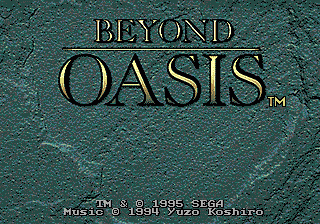
Original Release Date: December 9, 1994
Original Hardware: SEGA Mega Drive
Developer/Publisher: Ancient/SEGA
In my article covering The Legend of Oasis, I already talked a little about Ancient Corporation. In short, the company was co-founded by famed composer Yuzo Koshiro and his mother, Tomo Koshiro, in 1990 in order to officially enter a development deal with SEGA. Koshiro had only done music for games up to that point, but he wanted to try his hand at more. For their part, SEGA needed someone to handle development of the Master System and Game Gear Sonic the Hedgehog games. After doing a fairly good job of that, Ancient was then tasked with assisting on the development of Streets of Rage 2, a sequel to the surprisingly successful SEGA belt-scrolling beat-em-up. At the same time, Ancient also made contributions to ActRaiser 2 and Robotrek, though mostly with regards to audio matters.
It wasn't until nearly four years later that Ancient finally got to develop something original of their very own. SEGA's 16-bit console was in a weird position during that generation. While it had failed to catch on in the Nintendo-dominated country of Japan, it was punching well above its weight in the rest of the world. This made for an interesting problem for the company. Most Japanese game companies had a tendency at this time to focus on the domestic market above all, a tactic which made a lot of sense for those publishers best known for RPGs. Japanese-style RPGs simply hadn't caught on well in the West yet, so the market was completely lopsided in Japan's favor. Thus, SEGA generally had to provide their own games in that genre if they wanted them. Luckily, they had quite a bit of great talent to work with in that regard.

By the time Beyond Oasis was released in late 1994, however, time was running out for the Genesis in Japan. The Saturn launched just before the end of the year, and SEGA of Japan clearly saw greater opportunities in betting on that hardware than trying to make something of the Genesis. Over in the West, SEGA was having a different problem. The Genesis was enormously successful, but its tech was really starting to show its age. SEGA of America was hesitant to put an end to the system, though, as software sales were still very strong. To that end, they put their support behind a couple of ill-conceived peripherals that asked a lot of money of customers to try to prop up hardware ready for retirement.
On the bright side, it meant that SEGA kept right on localizing nearly every interesting-looking Genesis game no matter how late it released or how niche it might have seemed. In a way, Beyond Oasis could not have had better timing. The character designs by Ayano Koshiro had a lot of appeal in market still in the throes of Aladdin-mania, and the action-oriented gameplay was more palatable to Western tastes than a more traditional RPG would have been. It looked great, sounded amazing, had a theme that stood out, and gameplay that was very well-suited to a gaming audience feverish for fighting games. Beyond Oasis didn't smash any sales records, but it did better than anyone expected it to. Ancient had pulled off the difficult task of successfully launching a new console RPG property in the West.

Sadly, SEGA of America's fears turned out to be valid. SEGA would never again see the level of success that they achieved with the Genesis. Not by half, even. Had it been otherwise, we might have been playing Oasis: Ali's Open World Adventure on our SEGA Pluto handhelds this year. Instead, the series ended after the poor sales showing of this game's follow-up. Ancient continued to work with SEGA fairly closely for a number of years after that, even contributing to the development of Yu Suzuki's Dreamcast adventure game Shenmue. They also made a few other action-RPGs, though none quite in the same style as Oasis. Their most recent game is a fast-paced tower defense game called Gotta Protectors, released on the 3DS in the West in 2016.
Compared to similar games in the genre at the time, Beyond Oasis is a really short game. While games like The Legend of Zelda: A Link to the Past, Illusion of Gaia, and Secret of Mana were all fifteen or more hours long, Beyond Oasis can easily be toppled in eight hours. A lot of that is owing to how linear the game is. There are some optional challenges along the way, and you're certainly able to wander around at times. There just isn't much of a reason to. The story seems to be pushing you along from one area to the next, and before you know it, the game is over. I probably would have been upset about that if I had bought the game instead of renting it, but it certainly made for the perfect weekend rental if nothing else. Sometimes if I couldn't find anything else to rent, I'd take another run through Beyond Oasis just because it wasn't a hassle to do so.

Indeed, I think the game's brisk pace is one of its strongest points. The game kicks off with a cool-looking cut-scene showing our hero Prince Ali coming into possession of a Gold Armlet. He returns to his home island just in time to see the village near the castle get attacked by ruffians. After taking care of them, you're nudged towards the castle, where your father lays out the job ahead of you. He tells you to find and awaken the four elemental spirits that obey your armlet so that you can stop the evil bearer of the silver armlet. With the next destination marked on your map, you head out to meet up with the first of the spirits.
Each of the spirits will require you to go through a dungeon of some sort, with each more elaborate and time consuming than the last. The first is basically a straight hallway with the spirit at the end. The second dungeon is much larger, less linear, and has some rudimentary puzzles to solve. By the third dungeon, you'll have to pull off some tricky platforming to go with the mazes and puzzles. It's a nice, smooth difficulty curve overall, though the platforming is always a pain due to the game's unusual controls. Basically, jumping and crouching are assigned to the same button. If you hold the button, you'll crouch. If you tap it or hold it and release it, you'll jump. It takes a lot of practice to get the timing down so that you don't fall into a brief crouch before a jump, and until you master that, you're probably going to make a lot of jumping errors. It's probably the main source of frustration in the game.
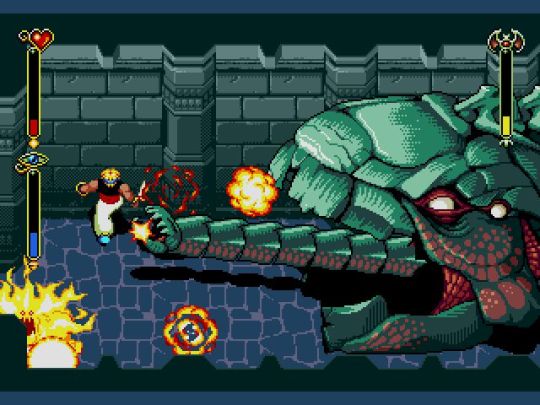
By contrast, the combat generally feels good. It's a bit stiff, particularly in comparison to its own follow-up, but it works well. Ali has a variety of special moves you can learn, and you can supplement his standard dagger with a number of different bonus weapons. Those weapons have durability limits, unfortunately, but the game throws enough of them at you that it really only becomes a mild issue at a few points during the adventure. There's nothing that you can't kill with your dagger, and if you happen to need anything else for puzzle-solving and the like, the game will almost certainly provide it for you. Various elements are more interactive with each other than you might expect. You can smack bombs back at enemies to have it explode on them instead, and any enemy that uses fire as an attack has a pretty good shot of lighting its friends up while it goes after you. These kinds of unexpected bits of logic help the world feel more alive, even if all of it is quite rudimentary.
As you meet up with each elemental spirit, you gain new abilities to help you out. The spirits can be very helpful, but you can only call them if there is some trace of their element around. Once they're out, you can keep them out so long as you have magic points remaining. Unfortunately, keeping them out causes your magic points to drop steadily. Again, necessary paths will almost always have a means of calling the appropriate spirit nearby, but there are lots of optional things to find that require you to keep the right spirit out and active for a while. The rewards for these optional paths rarely match the effort, but in a weird way it takes a lot of the pressure off of finding them, so I guess it's alright.

The game looks and sounds a treat as well, though that's probably to be expected from Ancient. Given the hardware limitations, the game really does look fantastic. The animations are good, the use of colors is superb, and there's quite a bit of variety in the surroundings. Koshiro had Genesis audio down to a science by this point and uses this game as an excuse to stretch his legs a little and try out some new styles of music. Some people don't care for it, but I think it does a good job of setting the atmosphere. The sound effects are great, too. You get a nice feeling of the impact when you hit an enemy, which is essential for an action-RPG in my books.
Outside of a few of the platforming segments, Beyond Oasis is just one of those games that is enjoyable to play on a very fundamental level. That and the presentation are the two aspects of this game that truly shine, with the rest of it tending towards adequacy rather than excellence. But it's enough. For a relatively brief game like this, I don't really care if the stories and characters don't go anywhere interesting. Nor am I particularly bothered by the lack of side-quests and other optional content. I really appreciate that stuff in some other action-RPGs, but I'm totally okay with how Beyond Oasis does things. It knows the kind of game it wants to be and does a great job of achieving its goals, and I think that's one of the reasons why the game has held up so well over time.

Indeed, I think I saw more people talking about Beyond Oasis when it got its Wii Virtual Console re-release than I did at the game's original launch. The game had a slight bit of competition due to coming out in North America just a month after the highly-anticipated Phantasy Star 4, and I think it got a little lost in the shuffle for some RPG fans as a result. The game certainly sold well enough, so someone was playing it, but I think the Wii Virtual Console opened a new audience for the game. While it was typically left out of Genesis compilations before that, it's been in most of the ones that have been released since and is now, I think, regarded as one of the many gems of the system's library.
If you want to play Beyond Oasis, you have lots of options open to you. As mentioned, it's on the Wii Virtual Console. It's also available in the Sonic's Ultimate Genesis Collection on PlayStation 3 and Xbox 360, as well as the SEGA Genesis and Mega Drive Classics Collection on Steam. If you want to play it on the original hardware, it can be a little expensive for anything other than a loose cart. Even then, you're looking at paying $30 or so, which is somewhat high relative to many games on the system. It's definitely worth playing no matter how you do it, though. Its brevity means it's not much of a burden to fit it into your schedule, so if you want to fill this particular gap in your history, I'd highly recommend it.

Previous: Shining in the Darkness
Next: Landstalker
If you enjoyed reading this article and can’t wait to get more, consider subscribing to the Post Game Content Patreon. Just $1/month gets you early access to articles like this one, exclusive extra posts, and my undying thanks.
#retro#gaming#sega#ancient#sega genesis rpg spotlight#genesis#mega drive#rpg#beyond oasis#story of thor#yuzo koshiro
3 notes
·
View notes
Text
Taylor Swift's 15 Best Songs: Critic's Picks
From her beginnings as a country artist to her reign as a global pop star, Taylor Swift has become one of the defining artists of this century -- and that’s in large part thanks to her masterful song craft. Each era of the singer-songwriter’s career has included intricate, instantly memorable musical moments that it’s difficult to narrow down the best of the best to just 15. Yet these songs represent Taylor at the top of her game, whether it be through an extended heartbreak anthem or hilarious declaration of independence.
Here are Billboard’s picks for the 15 best Taylor Swift songs, from her self-titled debut through 1989.
15. Taylor Swift, "New Romantics"
A bonus track off 1989 that out-popped the bubblegum pizzazz of most of the standard track list, “New Romantics” finds Swift gliding alongside gooey '80s synths before pogoing on the chorus with a slew of declarative statements. “Heartbreak is the national anthem -- we sing it proudly,” she states, making “New Romantics” a spiritual cousin to the “miserable and magical” time she had on “22.”
14. Taylor Swift, "Fearless"
A song like the Fearless title track demonstrated why, even as a teenager, Swift’s songwriting was miles ahead of her country contemporaries. The lyrics include several Swiftian hallmarks -- dancing with a romantic partner in the parking lot becomes dancing with a romantic partner “in a storm in my best dress”! -- but that opening line, “There’s something ‘bout the way/ The street looks when it’s just rained/ There’s a glow off the pavement,” effortlessly creates a sense of whimsy and romance that not many artists can pull off.
13. Taylor Swift, "Mine"
The lead single from Speak Now, Swift’s follow-up to the Grammy-winning Fearless, is more muted than its predecessor’s “You Belong With Me”and “Love Story,” and understandably so: It’s a song about not just finding love but maintaining it when the meet-cute has drifted into the past. When that final chorus hits and reaffirms the caring at the heart of this Taylor Swift song, though, it’s one of her most moving moments to date.
12. Taylor Swift, "Tim McGraw"
Taylor Swift sure has come a long way from the first track on her first album, huh? Although “Tim McGraw” sounds nothing like her pop stylings, the charming debut features the same type of vocal resonance and clever wordplay that have become calling cards for Swift. Plus, the fact that she pulled off the line “When you think Tim McGraw/ I hope you think of me,” and then proceeded to become even bigger than Tim McGraw, is something to marvel at.
11. Taylor Swift feat. The Civil Wars, "Safe and Sound"
The bad news is that one of the very best Taylor Swift songs, the dark, devastated “Safe and Sound,” is not featured on any Taylor Swift album. The good news is that we live in a playlist-friendly culture, and that this collaboration with The Civil Wars for the first Hunger Games soundtrack can be included in any mournful collection of your choosing. A song about protection amidst terror, “Safe and Sound” features Swift’s voice at its most shattered, her best efforts pummeled by the marching drums outside her door.
10. Taylor Swift, "Our Song"
What if Swift had resisted the allure of pop music and committed to a lifetime of fiddle-filled country jams? We’ll never know the answer, but “Our Song” is a gloriously twangy testament to what Taylor once was, before her lyrical ability to find music in everyday life was translated to a different genre. Here, the bubbly words give way to the lush arrangement, which encapsulates the exuberance of first experiencing the world with a romantic partner.
9. Taylor Swift, "We Are Never Ever Getting Back Together"
Years after its release, “We Are Never Ever Getting Back Together” remains bitingly funny, an eye-roll of a pop song about a boy who just doesn’t get it through his thick skull that it’s time to move on. Swift deftly balanced sarcasm with the sincerity of the hook and nails one of her first pronounced attempts at mainstream pop (which became her first single to hit No. 1 on the Billboard Hot 100 chart).
8. Taylor Swift, "Teardrops on My Guitar"
Poor Drew: The object of Taylor’s affection in “Teardrops on My Guitar” has a soon-to-be superstar longing for him and he’s totally unaware. The standout from Swift’s debut LP boasts the type of nuanced songwriting that would eventually make Swift a sensation, and while the “I secretly like him but he likes her and he’ll never know how much I like him” dynamic is repeated throughout her catalog, “Teardrops” captures that resignation within a handful of striking images, most notably the title phrase.
7. Taylor Swift, "Blank Space"
There aren’t too many pop songs that turn on a dime in the middle of the second verse, but just as her unhinged character in the “Blank Space” video unravels midway through, so does Swift at the song’s center, diving into self-deprecation and mocking her well-documented romantic history outside of music. “Blank Space” works as far more than satire, though: snappy and uncluttered, it’s a fantastic sing-along dotted with quotable moments (“I can make the bad guys good for a weekend,” “Boys only want love if it’s torture”).
6. Taylor Swift, "Love Story"
It takes guts to name a song something as bold and straightforward as “Love Story,” but Swift’s breakthrough single makes good on the “story” part of the equation by unfolding a modern-day parable that somehow never slips over the edge into full-on cheese. Perhaps it’s the earnestness of Swift’s performance as a heroine searching for an escape route with her Prince Charming and finally realizing that reality can make room for their tale. Out of the millions of love stories in the history of pop music, “Love Story” stands out.
5. Taylor Swift, "Mean"
Simply put, a pitch-perfect rebuke of bullying. The Speak Now single posits that living well is indeed the best revenge, as Swift bashes her early detractor by predicting that her future is bright, while their future only contains minor victories (and a huge helping of meanness). Swift sings “Mean” in first person, but it’s not really for her -- this is a song for people who feel belittled and beaten down by others, who look to someone like Swift for uplift and assurance. “Mean” is designed to shout along with cathartically, and it succeeds.
4. Taylor Swift, "State of Grace"
A bulldozer of an opening to Red, “State of Grace” is Swift’s most sonically towering track ever recorded; it’s a good thing that its author headlines arenas, because no small room could contain this song’s might. Instead of relying on lyrical detail, Swift stacks guitar lines upon propulsive drums and lets the whole thing rip; instead of opting for a wordy chorus, the hook here echoes with conciseness: “I never saw you coming/ And I’ll never be the same.” At nearly five minutes in length, “State of Grace” stays exhilarating start-to-finish and will be one of Swift’s most enduring non-singles ever.
3. Taylor Swift, "Dear John"
One of the (many) reasons any man should think twice about screwing over Taylor Swift: She is capable of penning a visceral, eviscerating takedown as potent as any hip-hop diss track. “Dear John,” a mangling of ex-beau John Mayer, is nearly seven minutes of simmering anger -- but it never feels exploitative or unyielding, instead exploring the feeling of being taken advantage of and punctuating each chorus with a sorrowful “I should’ve known.” Swift uses “Dear John” to turn the gut-punch of being led astray into a clenched fist and declaration of survival. “I took your matches before fire could catch me,” Swift spits at her beloved-turned-enemy. And we, the listeners, simply get to sit back and watch the fireworks.
2. Taylor Swift, "Style"
“Style” is all about the details: the hints of the guitar lick in the verses, the echoing vocals of “out! of! style!” on the chorus, the tension in Swift’s voice when she debates telling her guy that it’s time to leave, the way “James Dean/daydream” and “red lip/classic” are perfect rhymes positioned on top of each other, the release of the “take me hooooome” on the bridge. On an album filled with very good-to-terrific pop songs, “Style” is the most finely manicured, the most well-produced, the most fully realized -- and still, the most affecting. Decades from now, musical anthropologists will study how pop could be this perfect.
1. Taylor Swift, "You Belong With Me"
Throughout the twists and turns of her career, Swift has changed sounds, collaborators, personas and approaches, but has not -- and perhaps will never -- eclipse the magnificence of “You Belong With Me.” Credit the song’s simplicity, echoing the thematic concept of “Teardrops on My Guitar” but amplifying the high school heartache and polishing the hook so that it never floats back down after leaving the ground. There are so many things to love within “You Belong With Me,” from the high heels/sneakers dichotomy to that double handclap during the bridge, but more than anything, it’s quintessential Taylor, the ultra-relatable protagonist who can sum up complex feelings in a vocal run or quick turn-of-phrase. “You Belong With Me” has been her defining song for years, and that’s because it’s her best.
ts1989fanatic I guess it’s all in the eye of the beholder or ear of the listener to decide what your own top 15 Taylor songs are. I have to say that most of these would make mine, maybe not in the same order as this list but close.
As for the article itself it’s nice to have someone acknowledge Taylor for her writing ability without slamming her for something or other in the same piece.
16 notes
·
View notes
Text
Soulcalibur VI review | Rock Paper Shotgun
Developer: Bandai Namco Studios Writer: Bandai Namco Leisure
Launch: Out now On: PC From: Steam Value: £50, $60, €60
That is Hooves. He likes to stab and parry and slash and communicate in an alien tongue about how good he’s in any respect of these issues. Hooves additionally enjoys setting people on hearth, and paralysing individuals with horrifying runes, which has led some observers (me) to dub him “Horse Geralt” after the hero of The Witcher three. Unbeknownst to Hooves, he is a clone of the Witcher. That’s proper, poor horsey doesn’t even know who daddy is.
Though this backstory of Hooves’ is my very own dumb invention, it’s no extra fanciful than any of the opposite tales in preventing sport Soulcalibur VI, a rampant, fun-loving area of swordplay and silliness.
To get one thing out of the way in which: I’m a preventing video games dabbler. An indignant wee toad, not a champion. I wouldn’t swear on a replica of Road Fighter II in court docket, however I benefit from the odd bust-up in Tekken 7 or For Honor or Absolver. There’s a tense satisfaction in memorising the appropriate button-slaps for a vaulting deathkick or a flurry of needle-like pokes. And much more satisfaction in stunning your self, and finishing up these dance-like combos in the course of sloppy battle towards some nervy skeleton in a giant costume. However extra on the odd warriors of this explicit preventing sport in a second. First, we should contemplate the constancy of its stabbing. That’s crucial.
The fundamentals are easy sufficient. There are horizontal assaults, vertical assaults, kicks and a guard button. It’s simple stuff, largely. Every character’s movelist is split into totally different pages. A single web page provides you all their predominant assaults: the slashes and lunges and heelstomps you’ll discover most helpful. It’s a strong introduction to every swordsperson. Maxi is a dandy who likes to hit individuals with nunchaku, for instance, after which he does a somersault, most likely from pleasure. Xianghua is a lady with a wobbly sword. She is blood kind B, and likes to carry out the next strikes: murdering you.
There’s additionally an honest tutorial constructed into the “Libra of Soul” mode. This can be a sort-of-RPG through which you journey round a map preventing pc enemies for factors. It’s largely good for studying the fundamentals by preventing an AI sensei early within the journey, who tells you the best way to parry correctly. All these educating strategies and coaching modes make the sport really feel like a great place to shuffle into the Soulcalibur world, and for a Tekken boy like me, that’s largely true. However being a Tekken boy, I’m additionally immunised towards a sure flaw of 3D fighters: terrible storytelling.
The story mode here’s a dangerous anime folded upon itself a number of occasions, like a soggy origami crane. Every character will get their very own paper sculpture of cringey dialogue and scatterbrained plot on prime of the vanilla marketing campaign. For loreheads, perhaps there’s something in these tales, however there wasn’t for me. And I’m guessing even followers care little about Xianghua’s quest for the sword of legend, or Kilik’s quest for the sword of legend, or Taki’s quest for the– you get the concept. The actual thrill is within the sidestep, the parry, the launcher.
Right here’s the place it will get complicated. Coming from Tekken or Road Fighter, the hidden sport of rock-paper-scissors-guard-throw-break-parry-reversal-counter leaves me a bit feverish. In multiplayer, the sport throws all its weight at you quickly sufficient. Making an attempt to take care of the onslaught, I delved deeper into the coaching modes, and shortly lumps of jargon have been sticking to my eyelids like gore. Deadly hits, guard impacts, reversal edge, run counters, soul cost, reverse impacts. Razzle dazzle preventing sport terminology. It’s nothing a diehard biffer received’t have the ability to swallow in a single gulp, however a slowpoke similar to I wants a little bit of time to sup.
However studying is nice. And you may solely actually study within the ring. Right here, glowing results and pop-up notes spotlight the risks. I do know when Nightmare (giant, impolite man whose solely good friend is a sword with a watch) spouts flames that he’s charging up an unblockable assault. I do know when Seong Mi-na (unremarkable lady everybody within the village needs to marry) twirls her pointy Guandao above her head that she is “soul charged” and can now do extra-damaging strikes. I do know when Cervantes (zombie pirate and creator of Don Quixote) strikes me with a crimson slash it means a “reversal edge”.
This can be a good ‘un, the previous reversal edge. It’s a cinematic second through which every participant has to decide to a single assault, or carry out a feisty dodge. It’s nice stuff, particularly whenever you each go for a similar transfer, clanging off one another and leaping again in a panic, earlier than taking yet another hectic guess. It’s a bit extra sophisticated than rock, paper, scissors. However mainly: a sideways slice will beat somebody attempting to kick you, a kick will beat somebody attempting to hack into you with a vertical hit, and a vertical chop will beat somebody swinging from the facet.
However when this and different strikes are all combined collectively by a well-trained participant, I fall to items. Which means two issues: I have to get higher. And that is extra sophisticated than it first seems to be.
Right here’s the place the “fight classes” are neat. These are small “the best way to” manuals for every assassin. They’re dry textual content dumps however in addition they break down the essential technique for every character. I thumbed by the recommendation for stick-swinging Kilik, for instance, and discovered the best way to maintain foes at vary with a handful of staple strikes: extensive, sweeping swings of his bo employees. Positive sufficient, after I went into an actual battle with that mentality, it labored. Wanting by Horse Geralt’s fight classes, I see that some strikes whip out his silver sword, which does extra harm to opponents pumped stuffed with soul cost. In different phrases, a great way to place down a raging bull of a participant.
These are the small print you usually have to search for in YouTube movies stuffed with impenetrable chess-like notations. I like these movies, however I’m glad to have some fundamentals defined within the sport itself, as a result of I’m an fool. 4 paragraphs in the past I wrote a couple of Guandao. I had no concept it was known as that. I needed to look it up by googling “chiense spear” [sic].
However I’ve been dancing across the true great thing about Soulcalibur VI lengthy sufficient. The character creator is the true star of this sport. It’s a feast of potentialities, providing you a bunch of fantasy races to base your character on, then forcing you to repeat and paste the preventing model of a predominant character into their slider-born physique. I’ve made a complete gang of lizard lads, and photographed them as in the event that they have been indulging in some reptilian stag do. I’ve created total Halloween boybands, mummies in waistcoats, orcs in hotpants, a skeleton with a bandana.
But all that is nothing in comparison with the hideous creativeness of the internet-at-large. Any individual has made Marge Simpson. Any individual made a Xenomorph. There’s Zoidberg and The Hulk and “Sexy Venom”. There are such a lot of good issues. Right here is Spiderman preventing a fully-functioning Magikarp.
The moment-to-moment preventing is robust stuff. While you and an opponent get right into a string of blocks and geese and parries, it takes on the power of a lethal tennis rally, and that’s all I actually demand from a preventing sport: a handsome injection of adrenaline. But it surely’s the preposterous and fantastic character creator that makes the entire thing stand out, offering sufficient daftness to take the sting of that adrenal hit. For lengthy stretches, I put aside the shoulder-hunching stress of ranked mode and simply frolicked in informal rooms, preventing shapeshifters and stone individuals and elves and inappropriately proportioned rabbit girls. Though, that model of fighter isn’t restricted to participant creations.
Leeriness is hard-coded into this sport. Girl swordsters duel with boobs akimbo, nipples perking by their leotards, asses clamouring to flee the claustrophobic boundaries of a HD monitor. Pull off the appropriate strikes and you’ll hit your opponent so arduous that their garments come off or deteriorate, and although this impacts all fighters, it’s arduous to not elevate a sceptical eyebrow at such a schoolboy characteristic, seemingly designed to let gamers lech a glimpse at Sophitia’s sideboob. None of this takes away from the clashing of spear and dagger, the standard of the preventing itself, however it nonetheless feels immature and embarrassing.
This lizard with a dick is ok although.
In all, I’m happy by my scrappy fights, and my tutelage of Hooves the horse man continues. One unhappy factor to notice is that £50 is a excessive worth, a fandom worth, and that’s a pity. As a result of the character creator, thorough tutorials and RPG-ish story modes are an open-armed invitation to people who would possibly usually run away from preventing video games with their arms flailing. I think about lapsed followers too, these bizarre vampires and demons and nightmarish Sonics would possibly assume to themselves: “I used to like Soulcalibur. Possibly I might…” However then they’ll see the worth tag, and all that good will and Dreamcast nostalgia will vanish like a closed browser tab.
If that’s you, I can’t blame you. You could possibly purchase a smelly armchair from Greg down the highway for £50, and also you’d most likely get simply as a lot adrenaline and problem from getting that into your third flooring house as you’ll preventing one other terrifying Voldo to the demise. However the second this goes on sale, good friend, the very second it drops its guard – you slice open your pockets and let it bleed. Since you’ll by no means have a good friend like Hooves.
from SpicyNBAChili.com http://spicymoviechili.spicynbachili.com/soulcalibur-vi-review-rock-paper-shotgun/
0 notes
Text
Listening Post, March 2017

It’s been a while since the Dusted staff has gone over the things we’ve been listening to (besides what we’re reviewing) of course, and a (relatively) new year and some new faces seemed like as good an occasion as any. Some witchcraft-based Liars reminiscing starts us off for a conversation that covers everything from the powerful emotions of the new Mount Eerie to a percussion record you can’t get digitally to the blues, and much, much more...
Ian Mathers
I guess one of the things about getting older as a music fan is that there's more chances with every year and every crop of new acts/albums to have a band you love but haven't played or thought about in a while pop into your head apropos of basically nothing. I still remember being back home some holiday weekend in my first year of university, idly flipping on MuchMusic, and seeing Ladytron's video for "Playgirl". It was shockingly out of step with what people were doing in 2001 (or at least what I was paying attention to), and I simultaneously loved it and felt vaguely marginal for doing so. Remembering "Playgirl" had me going back to their old albums, and slightly to my surprise I found that while I love them all (including 604, the most overtly throwback-y) the one that's aged the best is actually their slightly atypical synthpop/shoegaze (synthgaze? shoepop?) Witching Hour, from 2005.
youtube
My wife saw The Witch (or, I guess, The VVitch) when it played as part of the Toronto International Film Festival two years ago, and had been after me to watch it with her ever since, but I only felt in the right mood for it recently. Sure enough I loved it, but while I did think the score/sound design were great, ultimately it mostly had me reaching for my favourite Liars album (and, I suspect more and more, one of my favourite albums full stop), They Were Wrong, So We Drowned. It is, uh, not an optimistic record when it comes to human nature, politics, empathy, xenophobia, etc. I wish this didn't feel like such an apposite historical moment to brace ourselves and remember that sometimes there's just no avoiding the steamroller (cf. "Hold Hands and it Will Happen Anyways”). That the album tries anyways, if for nothing else than at least to leave a record of the injustice, feels important.
Damien Jurado, who has some fans here at Dusted, is a guy who's work I always respect but oddly enough generally can't get into that much; the exception is his 2006 album And Now That I'm in Your Shadow. I found myself listening to it late one night recently, which really is the perfect time for the record. I'd hesitate to call it a narrative, let alone anything like a concept album, but conceptually and emotionally it feels very much of a piece; whether or not these are the same people or even the same places the songs are suffused with desolation, infidelity, murder, loneliness. I've given his more recent work a listen or two and it's always been good but I think it's that for me And Now That I'm in Your Shadow is so singular in effect that Jurado's other work in the Catch 22 of me wanting it both to be exactly the same and somehow not just a retread. I do like one earlier (and creepier) song I heard somewhere, "Amateur Night", so maybe I should just find the album that's on and go from there. But maybe someone here has guidance for me.
Jennifer Kelly
Oh, Ian, you have just brought up two bands I LOVE, and, god dammit, we like different albums.
Per Liars, I am a dyed-in-the-wood They Threw Us All in a Trench and Stuck a Monument on Top fan. It was my gateway, for one thing, to ESG. I am also partial to a split they did early on with Oneida, one of those you-cover-mine-and-I'll-cover-yours deals, so here they are revisiting "Rose and Licorice."
youtube
One of the top live experiences of my entire life was a show with Yeah Yeah Yeahs opening (after the first EP, before the first album), Liars (just off Trench) and Sonic Youth (I'm thinking maybe Murray Street?), where I just kept saying, this cannot get any better, the next band will be a let-down, and then the next band ratcheted it up and obliterated everything before it.
I also like that Jurado album, which was, I believe, the last one before he hooked up with Richard Swift and went less acoustic folk, more psychedelic, but my favorite ever of his is Mariqopa. I feel like he kinda flattened out the mythology by explaining it (circa Brothers and Sisters of the Eternal Sun), but in this album it's just sort of luminously, weirdly there, like a spaceship in the middle of a cornfield. You have no idea what it's about, and that makes it about everything.
Bill Meyer
I can't contribute much to discussion of the Liars or Jurado; neither exerts much attraction upon me. Two records that have ben drawing me back are Jon Mueller's DHRAANWDN (aka Hand Drawn) (Rhythmplex) and Eli Keszler's Last Signs Of Speed (Empty Edition). Both are limited edition double LPs by drummers, and both transcend whatever expectations you might have of a drummer's record. Beyond that they are very different. Mueller's comprises four sides of solo performance drawn from a six hour session he recorded in a Shaker meeting house. The drum kit plays the room's acoustics, resulting in waves of surging, polyrythmic sound. The sleeve, which varies a lot of white space with die-cut cut-outs that reveal a text about transformative experience and images of human-free environments, expresses the album's titular concept, as does the fact that you can only buy the physical object - there aren't even any digital promos.
Keszler's album, on the other hand, is a response to his performances over the past couple years at electronic music and dance venues. The extravagant bass presence counterbalances the precisely choreographed blizzard of discrete sounds that he generates with the rest of his kit, creating an impression of multi-dimensional space. Keszler creates a virtual space in part through physical effort, while Mueller inhabits a space that is physical but devoted to the spiritual. Both records are beyond solid.
Derek Taylor
I can’t really speak to any of Ian’s musical selections so I’ll speak to his filmic one instead. I too loved the The VVitch for its exacting verisimilitude and expertly wrought and rising dread. Lots of great themes to unpack therein and Robert Eggers decision to go all in on a “what if there was actual veracity to events presaging to the Salem hysteria” scenario is a bold one as is the “damned if they do, damned if they don’t” plot arc of the film. Great casting too and a hair-raisingly satisfying denouement in the primeval (or is that prime evil?) woods that still sticks with me.
As to listening it’s been the usual juggle of new releases with older favorites. On the former front there’s, Deuce, tenorist Stephen Riley’s latest duo with pianist Peter Zak. The pair has a previous encounter and two more with Zak as a member of Riley’s quartet. It’s the usual amalgam of ancient standards this time with three interstitial “Interludes” by Riley interspersed and a gorgeous rendering of Joe Henderson’s “Tetragon”. They also tackle my favorite standard “Everything Happens to Me”, Riley pulling apart and contorting the melody like fluffy cotton candy with his inimitable hardened-reed rasp and without losing sight of the gentle fatalism at the tune’s core.
In terms of classics, it’s been the series of bootlegs documenting the Charles Mingus Sextet/Quintet's 1964 American/European tour (Cornell, Town Hall, Amsterdam, Oslo, Stockholm, Copenhagen, Bremen, Paris x2, Wuppertal, and Stuttgart). Every date has its ample charms, but the Cornell University hit released on Blue Note back in ’07 is the one I go back to most frequently, both for the quality of the concert and its capture on tape. Trumpeter Johnny Coles had yet to fall ill and is featured splendidly alongside Eric Dolphy and Clifford Jordan and calling Jaki Byard and Dannie Richmond a rhythm section is like reductively referring to James Baldwin as an African American author, it barely scratches the surface.
youtube
Bill Meyer: Peak Mingus!
Jennifer Kelly: Have any of you been listening to Mount Eerie's A Crow Looked at Me? So powerful, so beautiful, absolutely harrowing...but I can't imagine how you could possibly review it.
youtube
Bill Meyer: I've never listened to Mount Eerie much, but this one is in my inbox and I didn't delete it because of the story attached to it. I think I need to check it out.
Ian Mathers: I need to get my hands on that Mount Eerie and listen, but I'll admit to being a bit daunted... my mother-in-law died in 2015 and it made (for example) the Sufjan Stevens album from last year a simultaneously important and really challenging listen. My wife is still dealing with a lot of the emotional fallout, and we are both Microphones fans from back in the day, so I might give it some solo listens first, so she has some idea of how tough it might be.
Jenny, I absolutely adore They Threw Us All in a Trench... too, I wish I'd had the chance to see them around then! I'm sure they're still good in concert, but there's something about that record that seems like it would be ferocious live. And your cornfield spaceship description honestly makes me really excited to check out Mariqopa—honestly the fact that Jurado did extend the mythology made me a bit wary, but as a standalone maybe I can approach it.
Bill, that Kezsler sample is pretty damn interesting.
Mason Jones
I'm a fan of Liars' They Threw Us... as well, and saw them around that time here in SF playing with Animal Collective if I recall correctly. They put on an entertaining show. That album and They Were Wrong... were both pretty powerful at the time, and then they lost steam somehow and became more predictable. Interestingly I thought their most recent album, Mess, was an improvement. Though slicker than it needed to be, there were good ideas percolating through it.
On the newer side, I've been surprised by how much I'm enjoying the newest Grails album, Chalice Hymnal. It's a pretty great combination of heaviness, stonedness, and kosmische rock. I also stumbled on the self-titled album by Helén, which is intriguing. Some is reminiscent of early Circle given the strong rhythmic foundation, but it gets into some rock-epic portions and, I don't know, prog-opera-something? Hard to describe and I haven't made up my mind whether it all works or not. But it's a worthy listen.
youtube
Bill Meyer: All right, I'm going to check out Mount Eerie.
I'll mention one other thing I've been playing lately. Having spent a bit of time with the Bruce Langhorne tribute album The Hired Hands this past month and the excellent Robbie Basho tribute Basket Full Of Dragons last fall, I'm ready to turn down my disdain for tribute records - at least when they involve very strong acoustic musicians honoring a great guitar player. So I dug out the first Basho Tribute, We Are All One, In The Sun, which was released by Important Records in 2010. I've been playing it over and over. Like Dragons, it was assembled by Buck Curran , who sure knows how to pick people who know their Basho. It begins and ends with Steffen Basho-Junghans playing variations on a couple of his namesake's tunes on a 12-string, and his lyric extrapolations make me really wish he would put out another record and finally tour the USA. But that's not to slight the excellent contributions by Meg Baird, Helena Espvall, and several others.
Brett Marion
I was witness to that same fantastic Liars/Yeah Yeah Yeahs tour leg too, caught them upstairs at the Magic Stick in Detroit. I was pretty smitten with Karen O at the time—from the cover of that first ep, and the range of her vocals—sometimes country accent, sometimes speak-sing, sometimes fragile, like on that “Crimson & Clover”-esque last song, “Our Time,” and then how she impossibly strangles the title to “aaaaaaaarrrrrrt staaaaaarrrr.” And Liars’ Angus Andrews seemed like seven feet tall. He might be. Great stage presence, both bands—exuding lots of confidence and attitude—but naïve, friendly, and approachable. I liked Trench a lot but thought They Were Wrong, So We Drowned was even better—it just nailed an overall Halloween feel.
Lately, I’ve had a hard time digging too deep in any one direction. The last half year or so I’ve been doing okay keeping up with Stephan Mathieu’s ambitious 12 CD release, Radiance, issued one month at a time, I think he’s through about ten so far. The last two, To Have Elements Exist In Space and Feldman have been one-track near hour-long pieces, so I haven’t made it all the way through those yet. The newest Six Organs of Admittance, Taylor Deupree, and PAN label stuff have been on, but not absorbed entirely. I also find myself getting sidetracked with making compilations that I occasionally post on Mixcloud (sort of the whole ‘80s-‘90s ‘mixtape’ thingy I’m sure we’ve all done for people), my latest—not completed—mixes/drafts being a ‘beginner’s guide to Alice Coltrane’ and ‘GAS,’ but it’s always a long process and I only ever get around to completing one or two a year, tops.
Bill Meyer: What does Mathieu sound like these days? I'm a bit out of the loop, although I have enjoyed some of his records immensely in the past.
Brett Marion: He sounds quite a bit like he always has—that grainy, shifting textural drone. Some tracks hit where it hurts so good, while others… meh. The last few year’s it seems he’s been into exploring more long-form pieces. One release, Nachtstucke, from 2015, featured a one hour piece, a piece over two hours, then two more around the half an hour mark. I wonder how many have made it through that over two hour piece more than once.
Bill Meyer: Well, I did just buy an LP he made with Kassel Jaeger and Akira Rabelai, I'll see how that one goes. Can't get everything.
Matt Wuethrich
I assume you mean Zauberberg on Shelter Press, Bill? Excellent LP. It's very diffuse in structure but still feels like there's a lot to take in. It's kind of a marvel how they embed they approaches within each other and shapeshift through different sonic spaces (Mathieu's manipulations of mechanical/acoustic historical recordings, Jaeger's field recordings, Rabelai’s digital treatments).
In my own listening I've been pretty deep into the official reissue of Giusto Pio's Motore immobile on Soave, sublime minimalism from Italy that first probably appeared on most people's radar through Alan Licht's minimalism lists (specifically Minimalism Top Ten III). Just organ/piano, voice and violin. Rich and hypnotic.
youtube
Bill Meyer: Yes, that's the one. I haven't scratched the surface but I am glad to hear that you find it deep. Gotta check out the Pio.
Justin Cober-Lake
I've been digging into a somewhat random cross-section of blues recently, connected to a project looking at possible points of connection between that genre and psalms of lamentation and maybe the book of Lamentations (though that may have a different focus). I don't have much to say on the subject yet, but I've been thinking about how the hill country artists really dig into an issue and stick there until it's worked out (or until the tape runs out or whatever). Charles Caldwell is the guy standing out to me right now, particularly his confused complaint on "Hadn't I Been Good to You." The Junior Kimbrough I grabbed this morning, All Night Long, was a sort of comical comparison, since it's largely a sex album.
youtube
There's something about the groove that makes this connection more noticeable, though I'm not sure how much it will translate to trance-blues acts like Otis Taylor (or even R.L. Burnside) who often use repetition more to set up storytelling or to do other things.
Derek Taylor: That’s an area of music near & dear to me, Justin. I coincidentally spun that Caldwell album this weekend too after re-opening a rabbit hole with the George Mitchell Collection box set. Such a shame it was Caldwell's first & last. Kimbrough (and really nearly all of those hill country guys from Burnside on down to T Model Ford) had copulation on the brain much of the time and its more misogynistic manifestations ("You Better Run") more often that I'd like.
I remember catching Burnside prior to & during the self-parody phases of his career and being pretty demoralized by the latter seeing him run through the tropes (“Well, well, well…”), and take copious swigs off a decapitated kewpie doll filled to the severed neck w/ whiskey. T-Model Ford was like that too (“It’s Jack Daniel’s Time!!!”, apparently between EVERY song). Fat Possum did a lot of arguable good in getting those guys gigs/tours/etc., but they did a fair share of bad too in enabling/reinforcing a lot of their worst tendencies.
Guessing you‘re familiar w/ Mitchell & the box, but if not I can’t recommend it highly enough. Mitchell did work similar to the Lomaxes, but with a level of candor & self-awareness that they often lacked. The accompanying booklet is nearly as priceless as the music as it’s filled with anecdotes of Mitchell’s travels & encounters, often hilariously so. This missive about Big Joe Williams is one of my favorites as it really captures the essence of the guy: "At one point, we drove with him down to St. Louis to find Walter Davis and Henry Townsend. On the way down, Big Joe announced that he had to take a shit, and I told him we'd pull into the next service station. And he said, "No, I like country shits. Just pull over to the side of the road—I want to take me a good old country shit."
Matt Wuethrich: A big, big second on that George Mitchell set...it seems to be rather low profile considering the wealth of material on it. Every time I spin it I discover some new gem. (For five discs, it's relatively inexpensive, too.)
Jennifer Kelly: Anyone else (besides Bill Meyer, who’s reviewed it) into that new Tinariwen? And, quick question, if anyone has access to liners, is that Mark Lanegan?
Also really, really digging that the Bug Vs. Earth collaboration, so dark and clanky and post-atom-bomb-ish, exactly what I need at this point.
youtube
Bill Meyer: That’s Lanegan.
Ian Mathers: I've heard you and others praise the Bug Vs. Earth album, Jenny, and honestly the two make for such weirdly fitting collaborators I'd want to check it out just based on the combination. "Dark and clanky and post-atom-bomb-ish" sounds about perfect for 2017. Would you mind uploading it to the drive at some point?
The blues are one of those genres where I know I like at least some of it, but something's kept me from going much deeper with it. My dad got the (de rigeur, I assume) Robert Johnson box set when I was a kid and I love a lot of that, and I've gotten the odd album or comp I've loved from Son House or Howlin' Wolf or Buddy Guy (in the latter case, specifically Sweet Tea) but that itch feels mostly scratched at this point?
Bill Meyer: I just listened to a bit of it, Ian. Yeah, it's dark and clanky all right. I think the sounds are cool, and I'm intrigued that the Bug has cottoned to Earth's restraint. I expected an attempt to lure Earth into less measured venting of darkness.
Derek Taylor: Guy’s Sweet Tea is a curious case as it involved him jumping on the Hill Country bandwagon w/ Kimbrough & Cedell Davis covers and a Fat Possum production facsimile. Some called it a crass cash-in, others a sincere stab at homage. I don’t go back to it often & when I do just in doses, but considering Guy’s place in the music I’m inclined to go with the latter take. Guy’s been a proponent of commercially viable blues since he got his start in Chicago with Muddy Waters, so it makes sense that he would be attracted the Fat Possum aesthetic at that time although the guys there have taken pains over the years to stress just how shakey that business paradigm is in the larger music business scheme.
Speaking of Davis, he’s definitely one to delve into especially the early material released on the L+R Living Country Blues USA series, half a cd, Highway 61, on the Wolf label, and his first for Fat Possum, Feel Like Doin’ Something Wrong. Utterly unique approach to slide guitar necessitated by partial paralysis from a youthful bout with polio. Some enterprising (if largely erroneous) journalist dubbed him the “Ornette Coleman of blues guitar”, if I recall correctly, for his ability to make familiar fascinatingly foreign through tonal plasticity. He’s apparently still kicking at 89 and put a record out last year. Some vintage footage:
youtube
Ben Donnelly
Liars’ dedication to conceptual switcheroos shows the long-term hazards of being dedicated to approaching each album as a blank slate. My fatigue has generally increased each time I try out the latest Liars, to the point that I don't check their releases out right away. I'm sure I'm missing some gems in there, and suspect it will all make more sense in the future. The ramblings of The Fall and Wire fifteen years into their careers makes more sense now. That said, that first pivot between the on-trend disco punk to graveyard junkyard percussion was landmark, one of those moments where the leading edge re-shuffles the received history. The arc from 1981 Danceteria to No Wave to Einstruzende Neubauten is pretty direct, but by 2000, all I could see was that one end resulted in "Love Shack" and the other in post-rock. Liars sent out a big signal - they were looking at history differently, felt free to jump between the connections they saw, and their revision enlivened everything. The early single "You Know I Hate Stupid Phones" goes a lot of places in two minutes, one of those gems that gets lost in their constant shuffle:
youtube
Ladytron I like even better. Artists who are so ready for Vogue Italia will always be held in suspicion in less fashionable quarters. I liken them to Siouxsie and the Banshees: art bands who are facile with hooks and glamour to the extent that it's easy to underestimate them. Approaching both, there's the temptation to put aside the style statements and the associations with lesser goth/electro acts and try take the brilliant singles and remixes as stand-alone artifacts. But that's a mistake—the mascara is as necessary as with Bowie and Prince. When they declared "they only want you when you're seventeen, when you're twenty one you're no fun" it's impossible to tell which side of the cynicism holds their sympathies. Probably both, which is why their best tracks frequently slap me like I haven't heard them a hundred times. This high concept obscurity, Missy Elliot rethought as Japanese synth-punk, still bewilders.
youtube
Ian Mathers: Derek, that Cedell Davis video is damn good, I'll have to track down an album.
Ben, I can't believe I forgot to mention Ladytron's "Oops" cover—literally one of one my favourite covers ever, and one where I love both it and the original about equally in a way that means I don't even know which one I'd pick if forced to (and also, incidentally, the place where Ladytron got closest to Add N to (X), if anyone remembers them). That early Liars track, though, I'd somehow never heard. I really, really love the bass sound on their early records.
Derek Taylor: Tenorist Fred Anderson’s birthday yesterday (he would’ve been 88) sparked a shelf perusal of his work. The flurry of activity in his final years leaves a pretty respectable discography. I opted for Black Horn Long Gone on Southport, a ’90 studio trio session in Chicago with Malachi Favors and the erstwhile AJ Shelton released in ’09. It’s a loose & limber date with Favors negotiating Fred’s singular horn vernacular in a sometimes akimbo manner that takes a bit of getting used to. Shelton, operating under his woke moniker Ajaramu, isn’t always entirely on the same page either, but occasional surface discombobulations don’t detract in the least from the deep reservoir of feeling feeding the music. The solo “Ode to Clifford Jordan” is the rare chance on record to hear Fred in that format for the duration of a piece.
Time spent with Anderson usually means revisiting the other two Freds that comprise my Fred triumvirate, McDowell & Wesley. Currently ears-deep in the Arhoolie collection Good Morning Little School Girl which cherry-picks from McDowell’s Janus-worthy repertoire of blues and spirituals. His wife Annie Mae & a small contingent from their Como, MS congregation join him on a couple of the latter.
#dusted magazine#listeningpost#ian mathers#jennifer kelly#bill meyer#derek taylor#mason jones#brett marion#matt wuethrich#justin cober-lake#Ben Donnelly#liars#damien jurado#Eli Keszler#Charles Mingus#mount eerie#grails#robbie basho#Stephan Mathieu#Giusto Pio#Charles Caldwell#Cedell Davis#mississippi fred mcdowell
7 notes
·
View notes